#they date back pretty far to roughly the 17th century so they were a thing for a looong time
Note
hiii!!! can you tell me what a posy ring is? i’ve never heard of that before
Of course ! Posy rings are essentially the old-timey versions of modern day promise rings, except back then they were typically just thin gold bands with some sort of an engraving on the inside. The inscriptions were intended to convey secret messages of love between the giver and recipient
Like this !

#asks#the more money you had the nicer they could be but they were almost always exclusively just gold bands like this#it's the wizarding world though so I shamelessly included the emerald gemstone to go with it because why not#they date back pretty far to roughly the 17th century so they were a thing for a looong time
9 notes
·
View notes
Text
Days 126-127: Edinburgh, Part 2 (History, Hiking, and Beer)
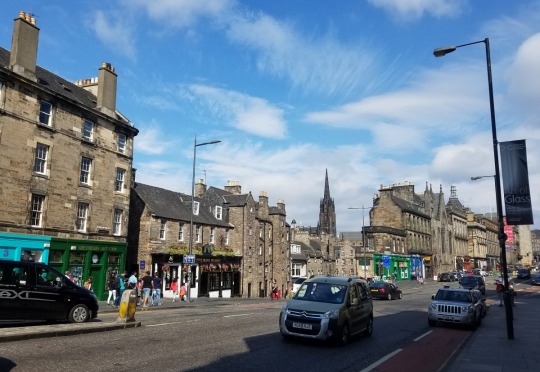
Our last two days in Edinburgh marked the two-thirds point of our journey in Europe, and the halfway point of my dad's stay with us in Scotland. So far, all we'd really seen of the city itself was the castle, the Whisky Experience, and a few square blocks around the train station in New Town. There's far too much for us to try and see everything, so we picked out a few top choices and did our best to enjoy them as much as possible.

After saying hello to the neighborhood cat, we took the bus into town toward our first stop of the day--the National Museum of Scotland. Now that we'd figured out Edinburgh's bus system, it was actually pretty easy and convenient. And compared to underground metros, buses give you a much better sense of how a city fits together.
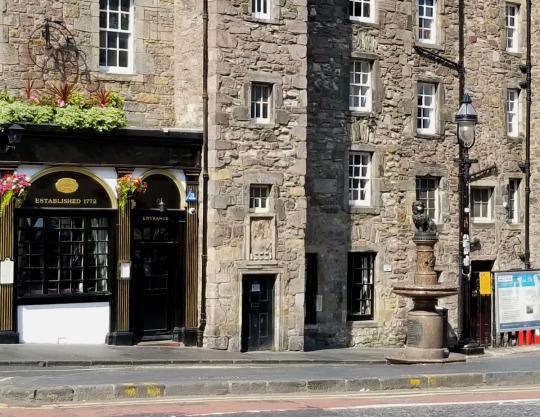
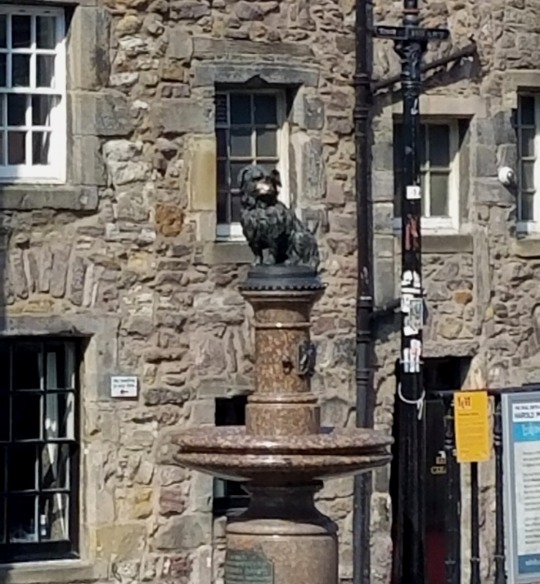
We got a closer look at the statue of Greyfriars Bobby, a legendary local terrier who faithfully guarded his master's grave for 14 years until his own death in 1872.
Passing Bobby by, we headed on toward the museum.
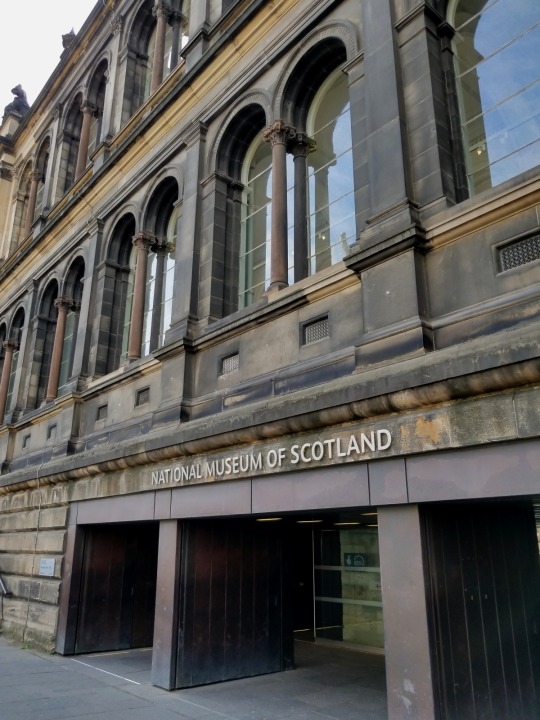
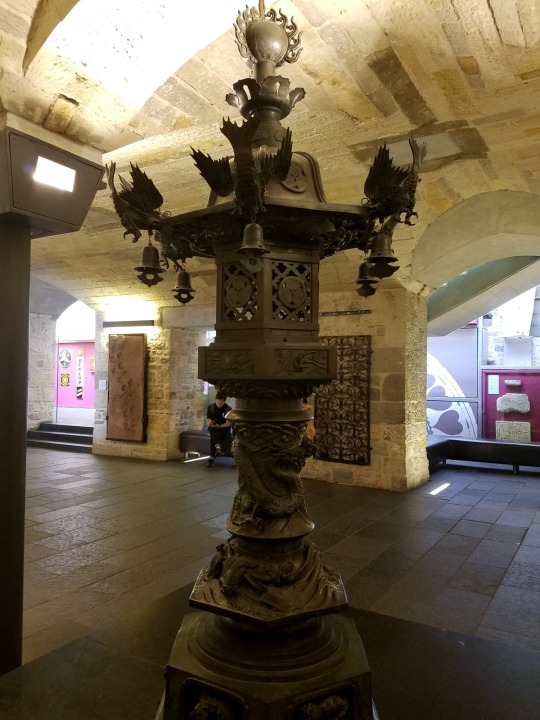
The ground floor entry hall had a diverse collection, including a 19th-century Japanese lantern presented on a precisely shin-high marble plinth. It's funny--when I ate it in the Rif Mountains of Morocco, tearing a hole in my pant leg and scraping up my knee, it healed up just fine after a few days. But when I banged my shin against that stone platform without leaving the slightest mark on my pant leg, it took off a chunk of skin underneath and left a deep scar that's still conspicuously purple six months later.
After killing some time in the gift shop--where I found a miniature Blackwatch-patterned umbrella to replace the much-bulkier one I'd been carrying--we joined up with a free tour that introduced us to the various sections of the museum.
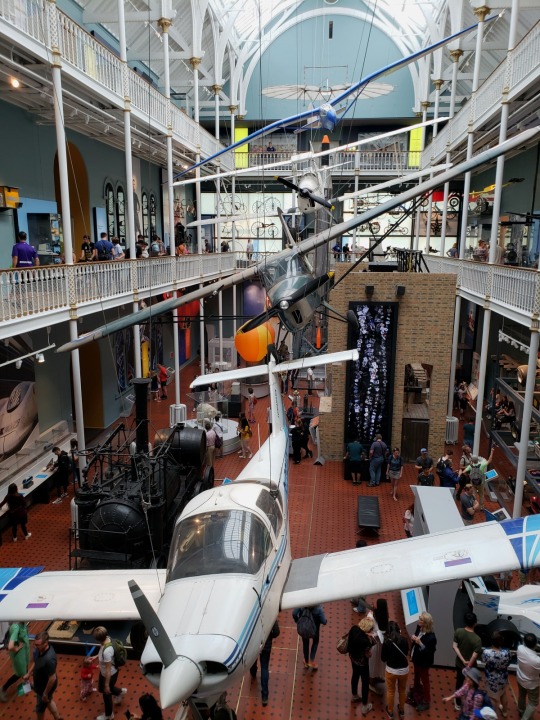
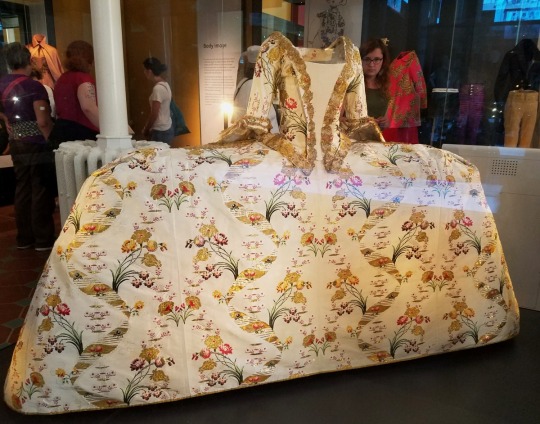

The Museum can be roughly divided into four sections: a Scottish history museum, a science and technology museum, a world cultures museum, and a natural history museum. It doesn’t compare to the British Museum in London, of course, but nothing can.
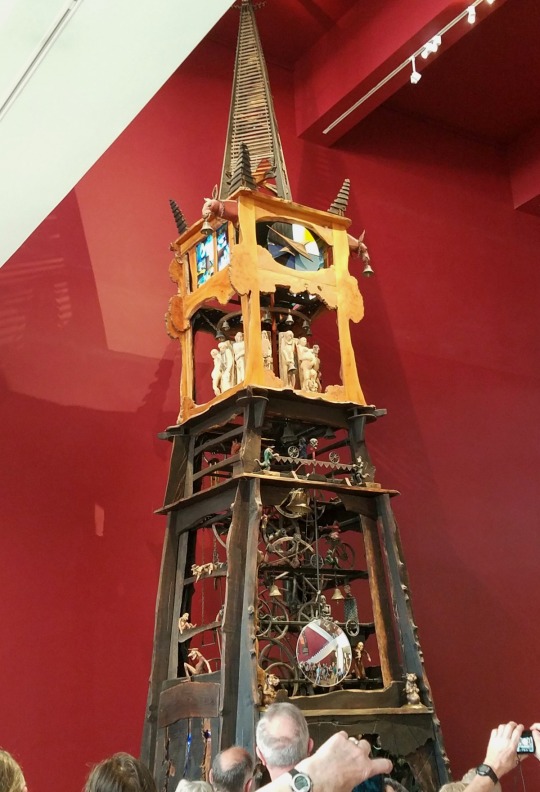
We saw a ridiculously complicated clock that our guide complained never works quite right.
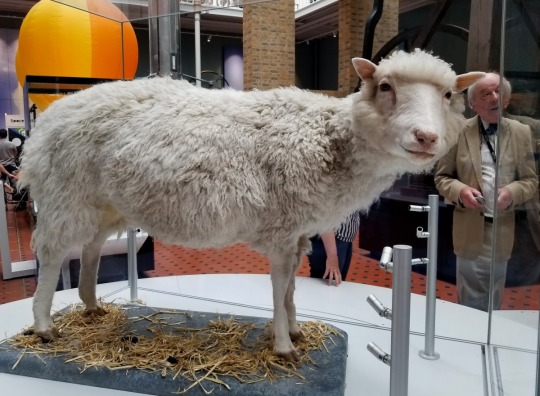
We also saw Dolly the Sheep, the first-ever successfully cloned mammal. Not a recreation--they actually stuffed her after she died and put her on display. We appreciated the attention to detail with regard to the sheep poop at her feet.
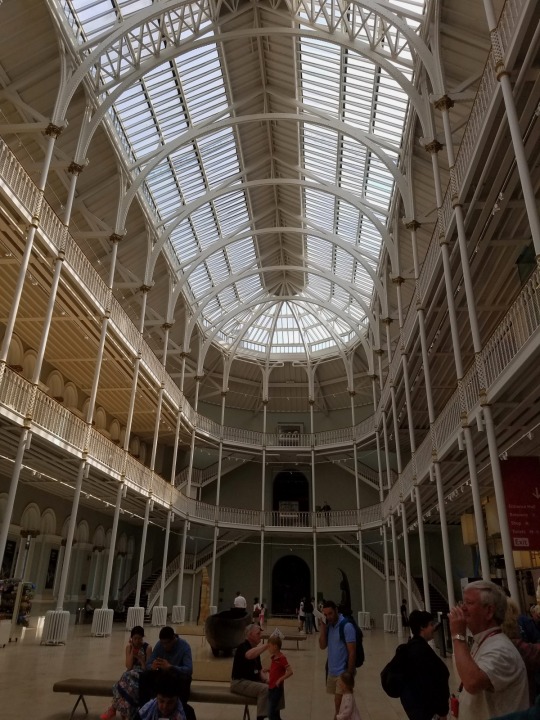
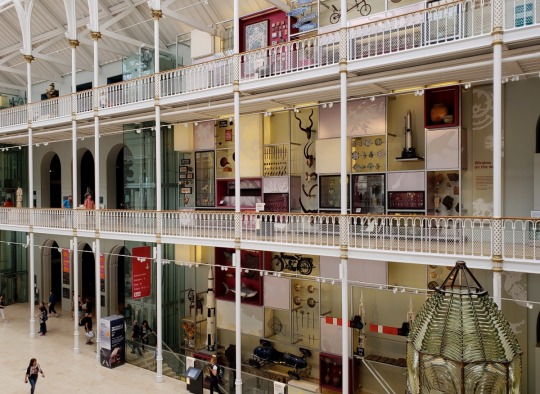
The museum is huge. At the center is a massive Victorian hall inspired by the Crystal Palace that used to stand in London. To us, it looked uncannily like the panopticon of Kilmainham Gaol in Dublin. Our guide was nice, but he was so soft-spoken that we could barely hear him most of the time. Once we felt sufficiently oriented, we broke off and went back to the exhibits we were most interested in.
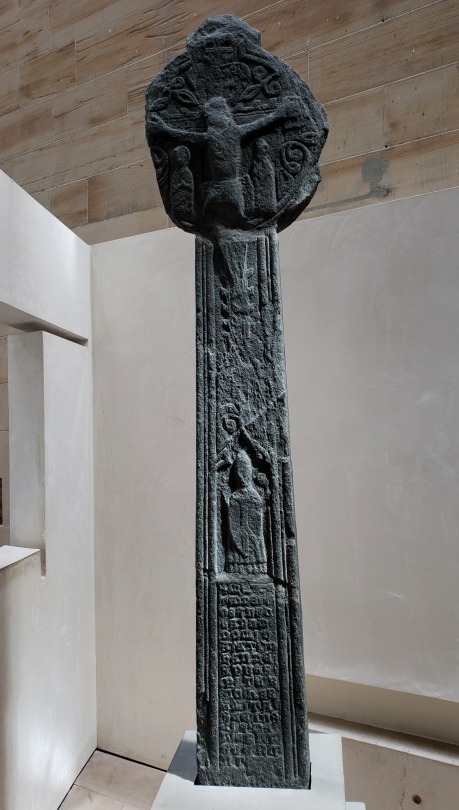
We spent most of our time in the Scottish history museum, which contains a very impressive (and well-displayed) collection of artifacts either made or found in Scotland, dating from prehistoric times up into the 21st century. Limited on time, we mainly stuck to the medieval history floor.
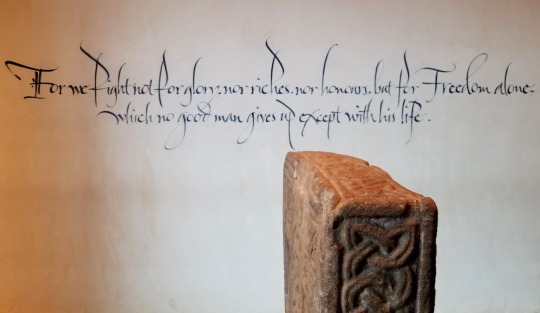
To either side of an old stone inscribed with Celtic knotwork, the walls bear a quote from the Declaration of Arbroath, a 14-century plea from the people of Scotland to Pope John XXII for support in their battle against the invading English army:
For we fight not for glory, nor riches, nor honours, but for Freedom alone, which no good man gives up except with his life. As long as only one hundred of us remain alive we will never on any conditions be brought under English rule.
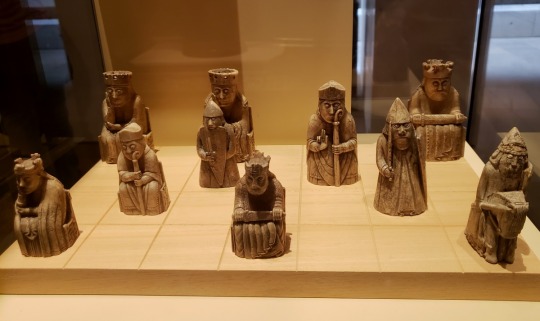
One of the highlights of the medieval collection are the Lewis Chessmen, part of a medieval Viking chess set discovered on the remote Scottish island of Lewis and Harris.


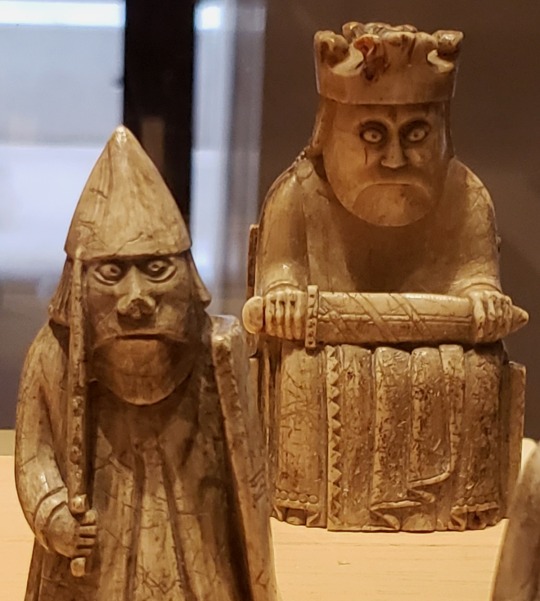
Eleven pieces of the set are here at the National Museum of Scotland, while the rest are in the British Museum in London. They are carved from walrus ivory and whale teeth with remarkable detail and emotiveness. They could be characters straight out of a modern animated Viking movie.
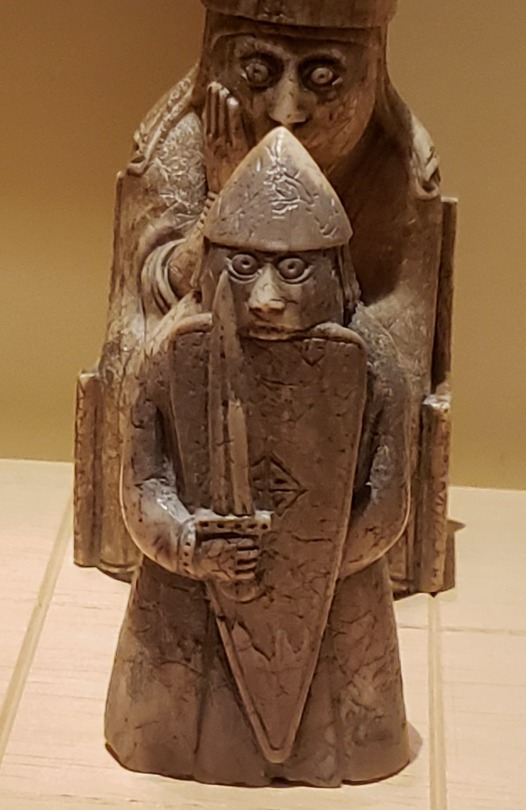
The rooks are depicted as berserkers chewing their own shields in battle frenzy.
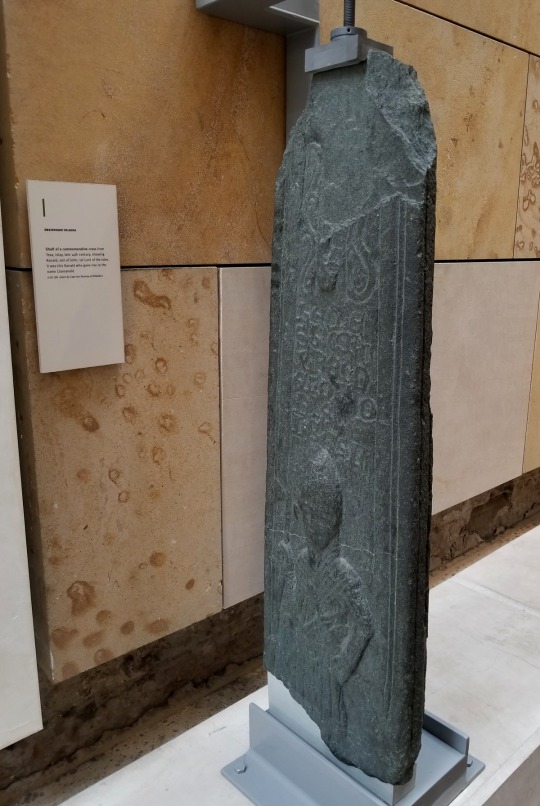
Nearby, we saw the remains of a Celtic cross from Islay, another Scottish island where we'd be staying next after Edinburgh.


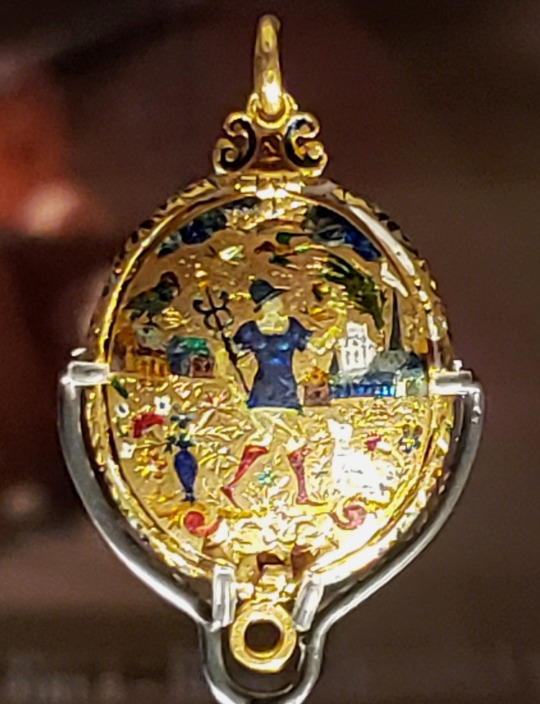

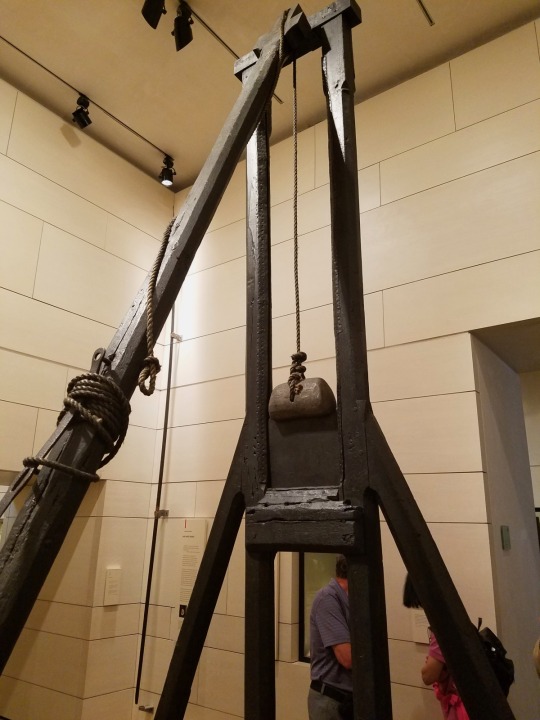
Some other highlights included a 17th-century Scottish flag said to have been carried in battle against Oliver Cromwell, a Celtic harp that may be the twin to the Brian Boru Harp at Dublin’s Trinity College, intricately detailed jewelry, some beautifully engraved early firearms, and a precursor to the guillotine known as “the Maiden”--gently used.
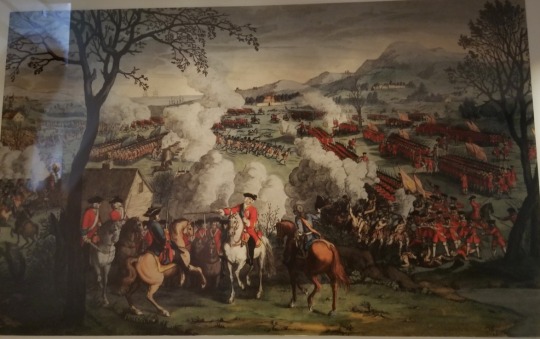
Upstairs, they have a good section on the Jacobite rebellions, when the ousted Stuart kings of England returned to their native Scotland to raise an army and reclaim the throne in London. It was a hopeless cause, and after three generations the rebellions finally died out.

Finally, we browsed through a section on the 1700s, when industries like textile weaving and coal mining were starting to boom like never before.
At the top of the museum, we discovered a fabulous view of the castle to the northwest and of the mountainous Salisbury Crags and Arthur's Seat to the east.
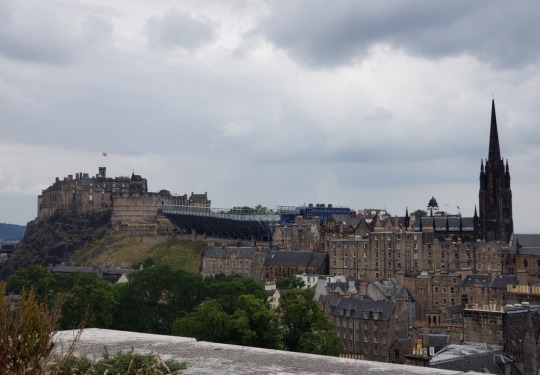

During one of our tours, our guide mentioned Arthur's Seat--a tall volcanic plug that overlooks the city--in a warning against taking online reviews at face value. Apparently, someone on TripAdvisor left a one-star review complaining that it was "just a hill."

The elevator was abominably slow--after spending a good while taking pictures on the roof, we returned to find people who had left the rooftop as we arrived still waiting for the elevator to make its next return. When it finally arrived, we weren't able to fit in, so we decided to make our way down the stairs instead. That may have been a mistake, though. The stairwells and back corridors were so maze-like that we literally caught ourselves going in circles before finding a room we recognized. It was like being back at the Lyon bus terminal.
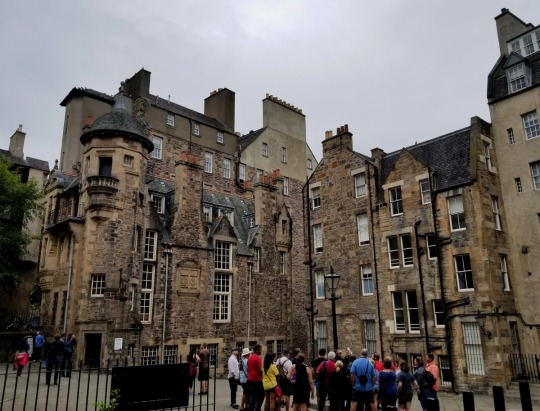
After the National Museum, I headed off on my own to do some shopping in New Town. Second-guessing my decision to not buy shoes until after Islay, I wanted to see if I could find anything good in the last big English-speaking city we'd be staying in. I didn't find shoes, but I did get some spectacular views.


One of the most striking things about Old Town is it's verticality, which I've mentioned before. The old stone buildings seem to be scrambling up on each other's shoulders, reaching for the sky. We'd also learned from Nik the day before that this is part of an Edinburgh tradition that far predates them. Throughout the Middle Ages, when the city was mostly made of wood, the constricting city walls forced people to build up, creating towering wooden "skyscrapers" that frequently fell down or caught fire. They were crammed with people, and the ensuing sanitation issues were legendary across Europe. It got so bad that Edinburgh earned the nickname Old Reeky.

That was why, in the 1700s, the wealthier citizens finally decided to escape the city walls and build a spacious Georgian-style New Town to the north.
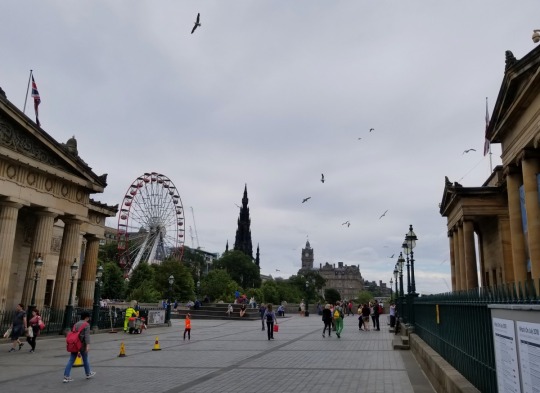
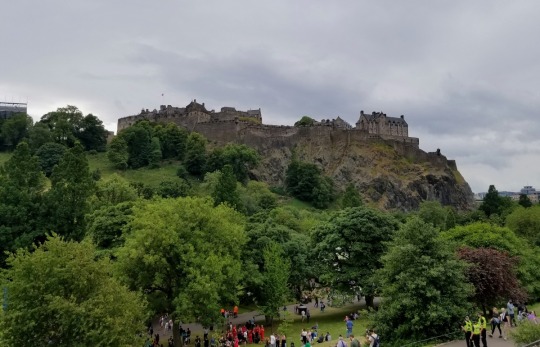
Down in the park where the castle moat used to be, people were crowding to see drum corps performing. August was still a couple weeks away, but the festival season atmosphere was alive and well.

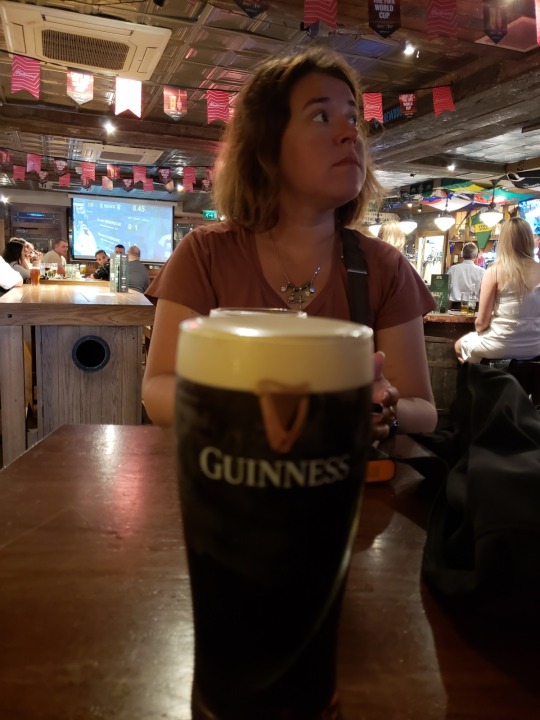
Meanwhile, Jessica and my dad searched out a pub where we could hole up and watch the final World Cup game between Croatia (who we were rooting for) and France. We’ve learned that Scottish people tend to have a great affinity for the French, if only because of their shared rivalry with the English. When the final whistle marked France's victory, the pub erupted in a celebration unlike anything I've ever seen in person.

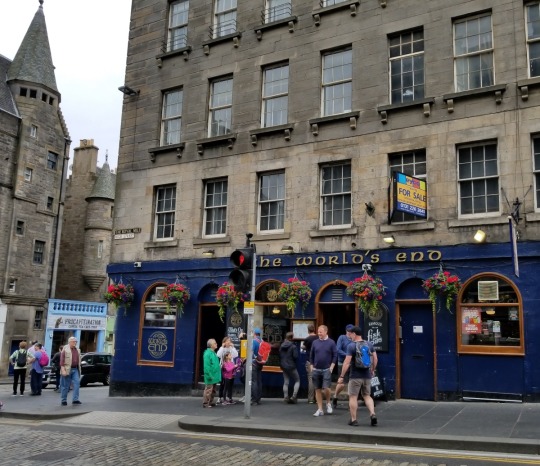
Emerging back into the overcast sunlight, we cooled off with a relaxing walk down the breezy Royal Mile. We wanted to get some dinner at the famous World’s End pub, but it was full up. The pub's name dates back to a time when it butted against the old city walls. Anyone entering the city had to pay a steep toll to pass through the gates, even if they were residents. For many people, this meant that if they ever left the city, they might never be able to get back in. To them, this pub might as well have been the world's end.
We turned back and ended up enjoying a wonderful dinner at an Indian-Thai hybrid restaurant--once we were finally able to find the door.
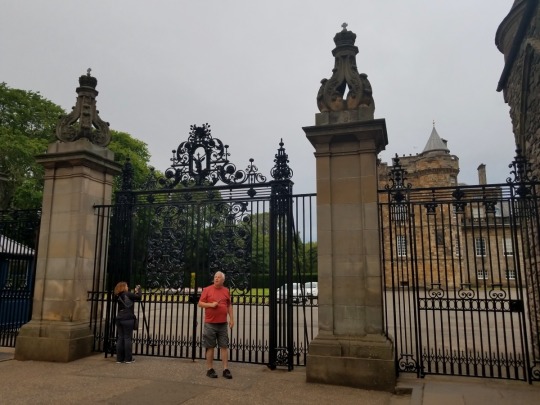
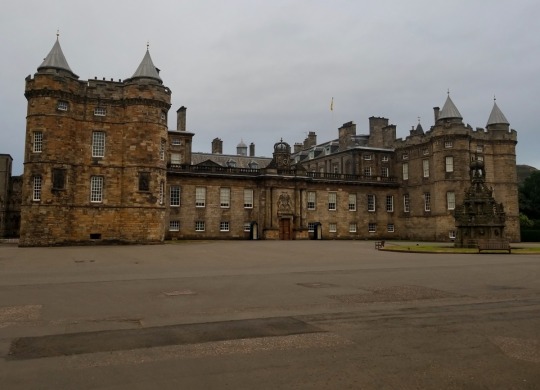

After dinner, we strolled the rest of the way down the Royal Mile to Holyroodhouse, Edinburgh's royal palace. It was well past closing time, but we were able to get a good view through the gates.

We also got to see the distinctive architectural style of the of the Scottish Parliament Building, and the Salisbury Crags jutting up dramatically behind them.
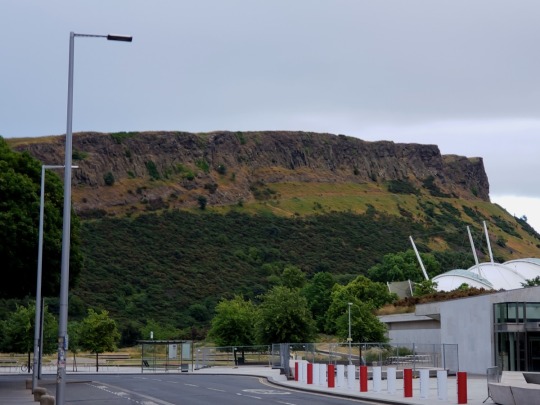
We'd be returning first thing tomorrow morning to hike the trail that runs beneath them. But for now, we ran to catch the bus that would take us back home. We tried to get my dad to watch the pilot episode of The Expanse, but we didn’t quite make it to the end before we were all starting to drift off.

The next morning, we bused back to Holyrood Palace and picked up where we left off--facing down the Salisbury Crags.
We--or at least I--didn't have the time or nerve to climb the larger Arthur's seat, but the Crags offered a nice compromise. And we didn't actually climb the top of the Crags. Rather, we followed the Radical Road that runs halfway up the Crags, along the foot of the cliff face.
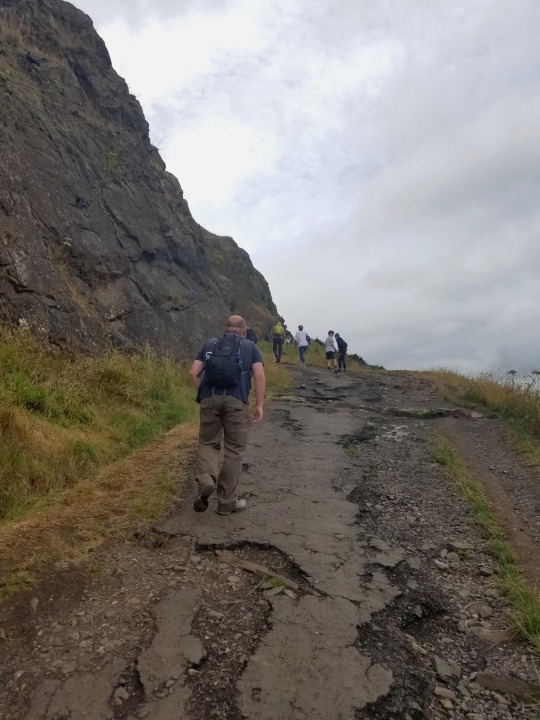
The Radical Road is named for a group of workers that took part in a nationwide strike in 1820 known as the Radical War. Wealthy Scottish citizens like Sir Walter Scot who supported the Radicals decided to support them by paying them to do other work while they were on strike--such as building a completely unnecessary road midway up the Salisbury Crags and parallel to a perfectly serviceable road that already existed.
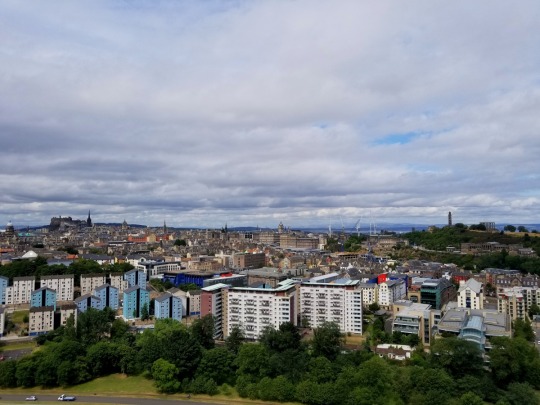

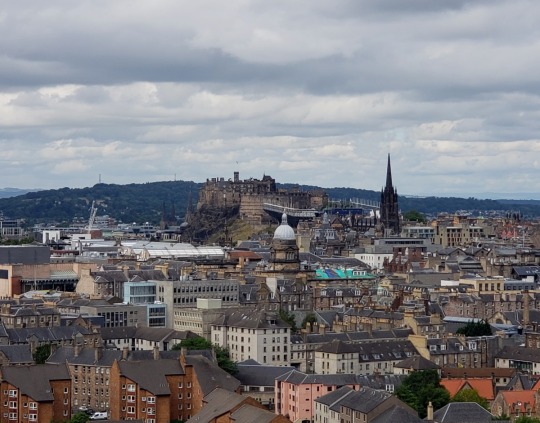
The beginning was steep, and my dad and I quickly started to question our decision, but all doubts were erased as we got high enough to see the view over the city.
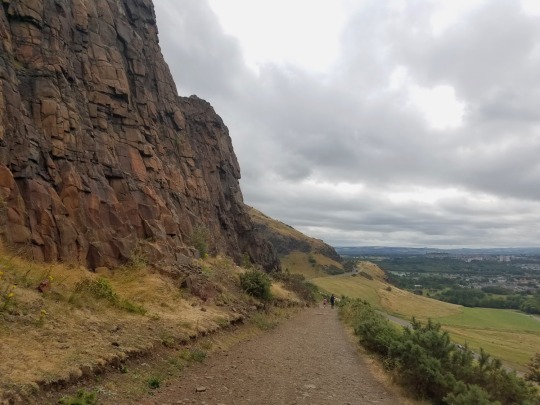
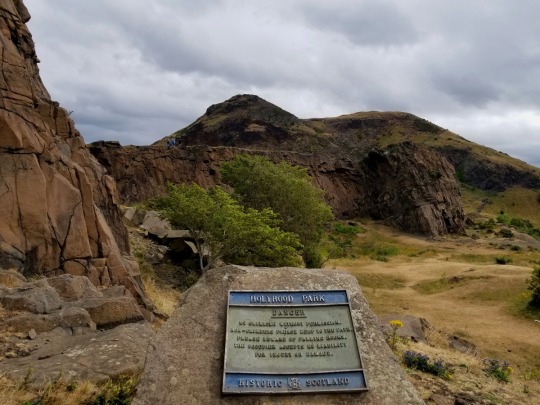

At its height, the road cuts through Hollyrood Park, which used to be the private hunting grounds of the kings and queens of Scotland.
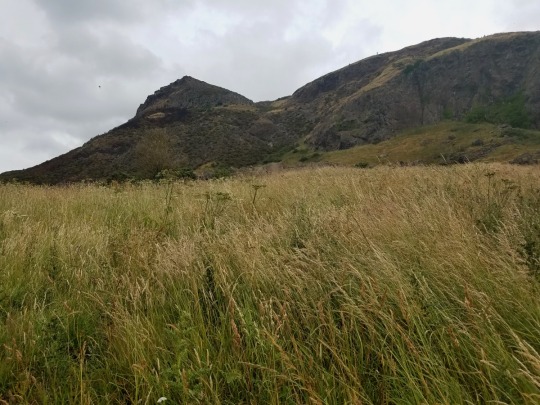

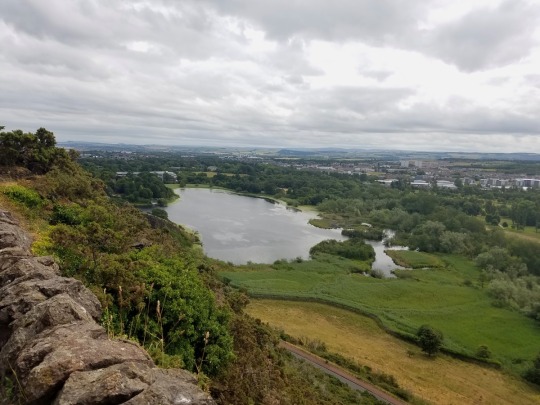
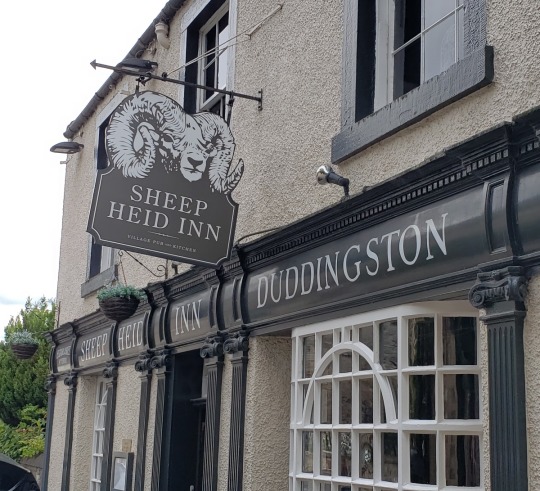
Reaching the end of the Radical Road, we kept on going toward the neighborhood of Duddingston and the highly-recommended Sheep Heid Inn. The inn has reputedly been in operation for over 600 years, which would make it the oldest pub in Edinburgh and possibly all of Scotland. The name comes from the old Scotts English for sheep’s head. The popular explanation is that King James VI of Scotland (and I of England) presented the pub owners with a golden snuff box engraved with a ram’s head on the lid. The pub was halfway between two royal residences, so James would often visit the pub along the way.
The kitchen wasn't quite open yet, so the three of us ordered drinks and enjoyed a rest after our hike. Once the kitchen opened, the food turned out to be just as spectacular as all the people who'd recommended it to us said. Jessica and I both had linguine with crab, shrimp, and chorizo. I don't even like seafood, but I loved that meal.
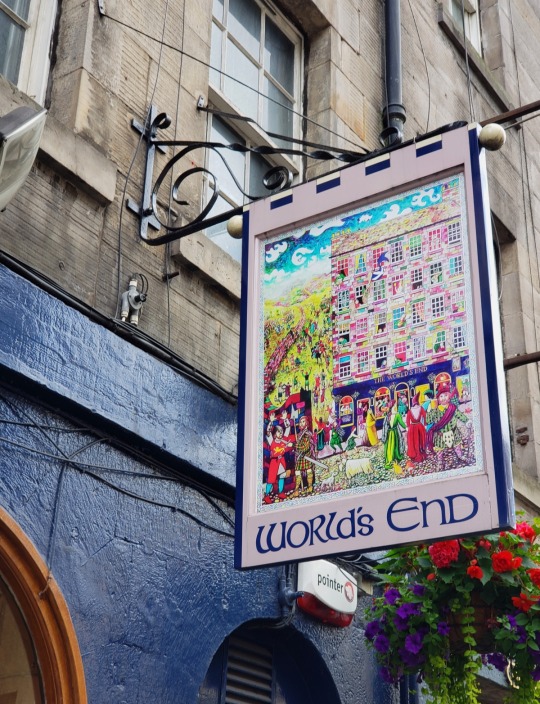
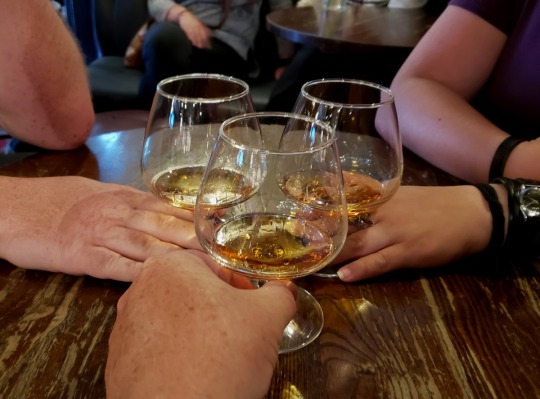
After lunch, we took an Uber back to the World’s End, where we each had a shot of Drambuie in honor of my dad’s Scottish friend John. For those of you who didn't know either, Drambuie is a sweet liqueur made from Scotch whisky, honey, and spices. A very distinctive beverage, it somehow manages to be both delicious and disgusting at the same time.

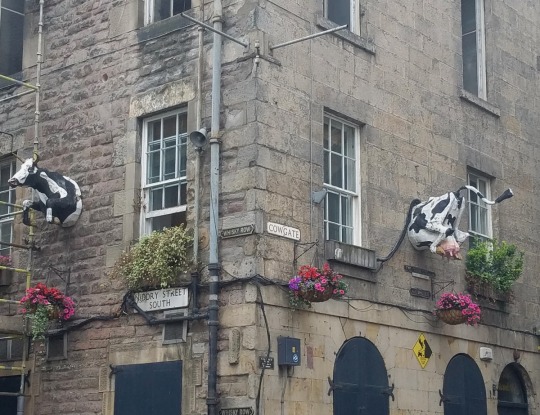
Our long-awaited toast complete, we decided to make it an official pub crawl and continued over to the BrewDog pub on Cowgate. My dad and I had learned about Brewdog from the TV show Brew Dogs, where the two Scottish brewers who run BrewDog travel the US crafting locally inspired novelty beers and converting beer skeptics to the way of the hop.
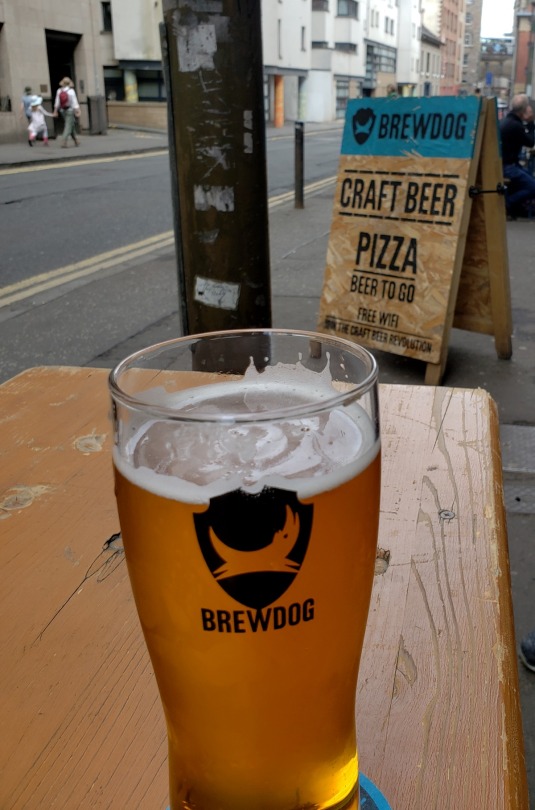
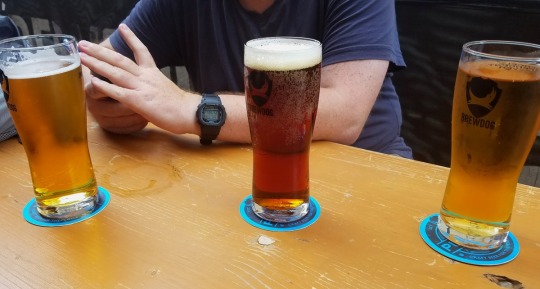
My dad had their signature Punk IPA, and I had their 5AM Saint red ale. I generally don’t like IPAs, but the Punk was surprisingly well-balanced despite being so hoppy. It had the sour and citrusy notes of a typical IPA, but very little bitterness. My ale was also surprisingly good. It was hoppier than any other red or amber ale I’ve had before, but the bright hoppy notes actually did a great job balancing out the ale and making it refreshing instead of heavy.
Jessica had a cider that was pretty good, too.
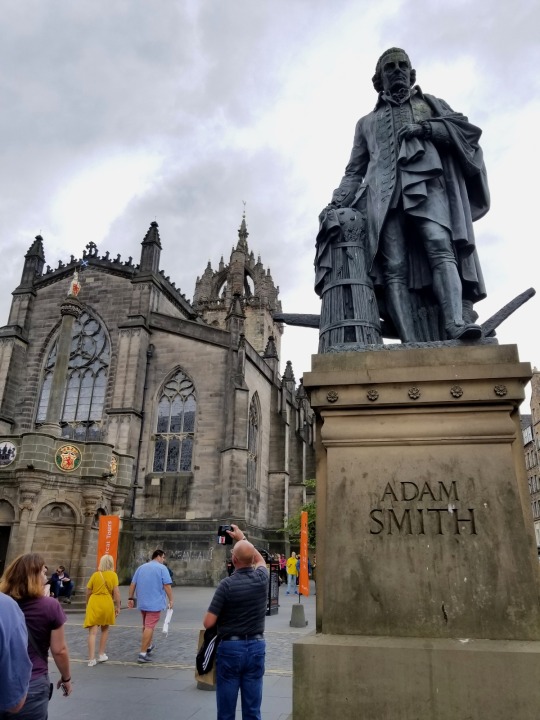

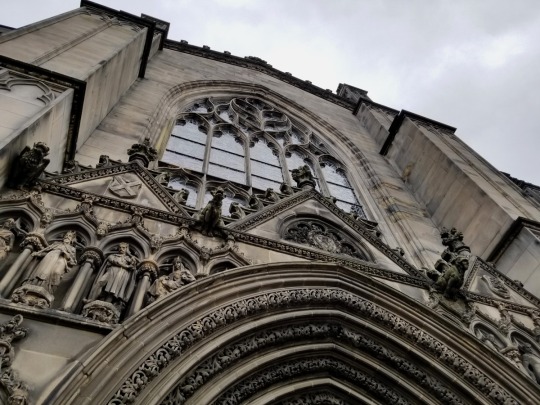
Went to St. Giles’ Cathedral, the seat of the Church of Scotland. It isn’t the largest, but it is stunning inside. The stained glass is mostly modern, but it is strikingly good.
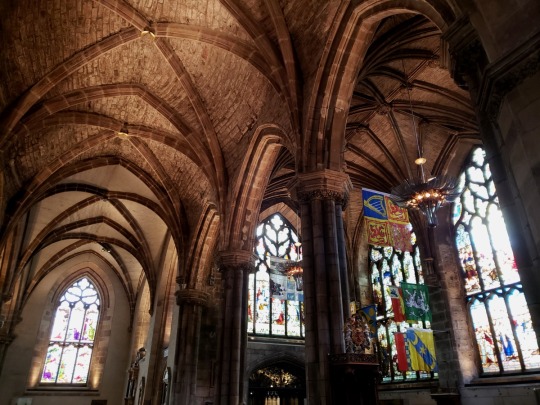

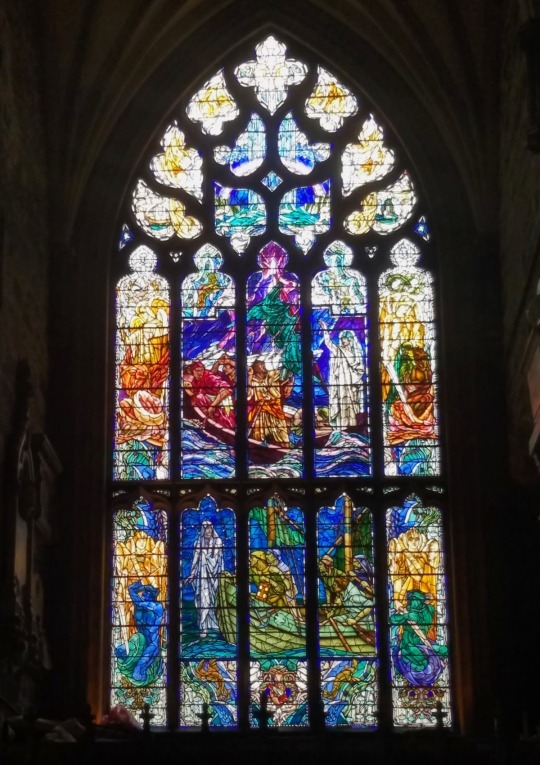
It's free to enter the cathedral, but you are expected to pay if you want to take pictures. And we can confirm that the people working there will not hesitate to call you out for breaking the rule.
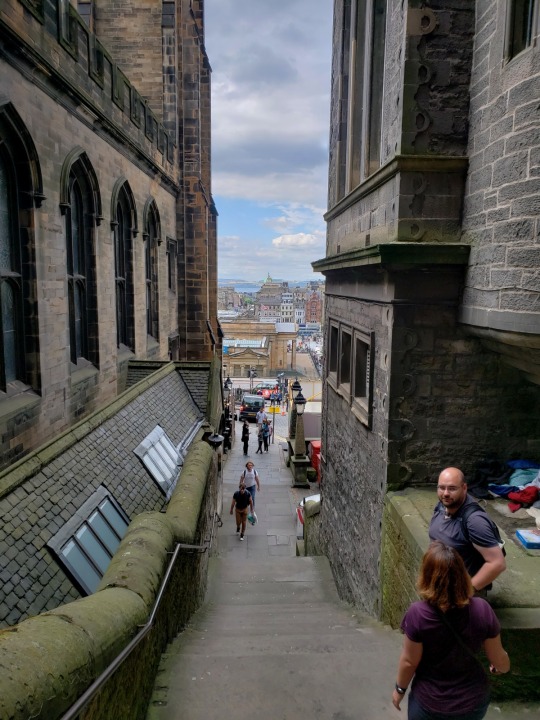

We still had some shopping to do--including picking up something for dinner--so we decided to walk over to New Town. I lead us along my footsteps from the previous day, taking Jessica and my dad through narrow closes and down the hill.
Tomorrow, we would head out early for Islay, so we caught a bus home with plenty of time to rest up and start packing.
Before I close our chapter on Edinburgh, I have to mention our charming hosts, Joyce and Ian. They were very kind and accommodating, but sometimes we felt that they didn't expect us to take them up on their offers as much as we did.
For example, they said we couldn’t use the kitchen to cook, but we could use it to heat a ready meal up in the oven. On our last night, we bought some meat pies that we didn’t realize at first weren’t microwavable. Ian said that it would be no problem for us to use the oven, and he even showed us some tips on how to get the crust to brown up just right. But when Joyce showed up and asked suspiciously what we were up to, Ian was nowhere to be seen.
It was a good time, and I’m glad that Jessica and I got to enjoy the British bed and breakfast experience several times during our months on the island. But we really found out just how strongly we prefer having a place to ourselves with a proper kitchen that we can use whenever we want.
Next Post: Islay (Introduction and Arrival)
Last Post: Hadrian’s Wall and the Scottish Borders
1 note
·
View note
Text
Epic Battles, Palaces and Concubines: A Chinese Studio’s Vast World of Fantasy
By Steven Lee Myers, NY Times, Dec. 2, 2018
HENGDIAN, China--If you are going to make a movie in China today about ancient warriors defending a mythical kingdom or a partisan resisting the Japanese occupation in the 1930s, or involving any variation of that staple of China’s entertainment industry--the back-stabbing concubine drama--chances are you are going to make it in Hengdian.
The city is home to Hengdian World Studios, which claims to be the world’s largest outdoor movie and television lot.
To call it a “lot” is an understatement. It is not one lot, but 13 of them, scattered over 2,500 acres in and around what was once a sleepy farming village nestled in the hills of Zhejiang Province, in central China.
There are other studios in China--Shanghai Film Park, for example. Only in Hengdian, though, will you find a faithful recreation of the palace of Qin Shi Huang, who ruled in the third century B.C. near what is today known as Xian, or of the capital of the Northern Song dynasty, which reigned from the 10th to the 12th centuries.
There is even a Forbidden City that is not only startlingly realistic, but also only a little bit smaller than the real thing in Beijing.
The one thing that might seem to be missing from its huge front gate is the photograph of Mao Zedong--except that the gate was constructed to look as it did during the Ming dynasty, not the later version known since the 17th century as Tiananmen.
“These scenes today no longer exist,” said Guo Huizhong, a director, as he filmed a war drama, whose title roughly translates as “The Last Bodyguard,” inside a building reconstructed as an opera house from the first half of the 20th century.
Moviemaking blurs the distinction between reality and fantasy, and Hengdian World Studios arguably does that better than any other place on Earth.
“This is where the empress committed suicide,” a studio assistant, Xu Hailei, explained as she guided an open cart through the faux Forbidden City, which, even up close, is pretty convincing.
“She jumped from there,” she went on, describing a historical fact of 18th-century China--the death of Empress Fucha--but also a pivotal scene in one of the most sensational dramas of the year, a 70-episode epic, “The Story of Yanxi Palace.”
“Yanxi Palace” streamed on iQiyi, China’s version of Netflix, from July to August, and continues to do so in China and dozens of other countries. It has been streamed 20 billion times, and its staggering popularity has influenced everything from fashion to the debate over China’s struggling #MeToo campaign.
It has also attracted more visitors to Hengdian, which distributes maps and postcards showing the sites where the series was filmed, including the building of the title, which means the Palace of Prolonged Happiness.
Ye Yunfeng, 24, came with her boyfriend from Lishui, a city not far to the south, because she wanted to see the hall where the emperor’s Grand Council met.
“The details of this show are very good,” she explained. “Many details, like the clothes, the headdresses and the backdrops, are in line with history.”
The serial’s creators, and its fans, judging from comments posted online, credit its success in large part to the attention to historical detail.
“The cost of actors and actresses are not expensive,” said Yang Le, the chief executive officer of Huanyu Film, the Beijing production company that produced “Yanxi Palace.”
Instead, the producers spent their budget on artisanal embroiderers to recreate the dresses and flowered headdresses of the era--3,000 outfits, some of which are on display in the company’s office in Beijing.
Yu Zheng, a screenwriter and producer of “Yanxi Palace,” said he wanted to convey an aspect of China’s “intangible cultural heritage”--combined with “the pacing of an American television series.”
“People in our generation are all watching American and British television series,” said Mr. Yu, who is 40, “but actually there are many traditional cultures in China that are very worthy of being promoted to the world. We have a lot of beautiful things.”
That is the illusion Hengdian World Studios was created to sustain.
The studio was founded in 1996 by one of China’s first billionaires, Xu Wenrong. His Hengdian Group made a fortune in electronic components in the early years of the country’s capitalist transition.
When an acquaintance needed a location for a film, “The Opium War,” about China’s humiliating loss to Britain in the 19th century, Mr. Xu agreed to build one from scratch in the company’s hometown.
Since then more than 2,400 films and television series have been made at the studio, including 337 between January and October this year.
On a recent visit, there were 15 projects being shot at the same time, requiring studio organizers to juggle schedules and enforce deadlines.
There are 400 distinct spaces where filming can take place, covering the entire breadth of China’s history, its culture and its architecture.
Two areas recreate Guangzhou and Hong Kong as they looked in the 19th century, built for “The Opium War,” and another reproduces the Imperial Summer Palace, which was sacked by British and French soldiers in 1860. Its ruins are preserved in Beijing.
There is also a recreation of the Communist Party’s wartime base in Yan’an and a replica of a Buddhist temple whose original on a hill nearby has since been closed to the public.
“Many people learn history through television dramas,” said Zheng Junnan, a production assistant for another concubine melodrama set in the Qing dynasty.
“I don’t read books often,” he explained.
Mr. Zheng, like many in Hengdian, is a transient; he moved to Hengdian for the duration of shooting.
There is a sort of union hall in the town center where people play cards and shoot pool while waiting for the chance to get parts as extras. And epic battles need lots of extras.
Another lot, “The Exposition City of the Ming and Qing dynasties,” is a reconstruction of ancient buildings that were torn down in nearby parts of China and hauled to Hengdian.
There are scores of courtyard temples, houses and other structures, including a wooden tower from Nanjing. Each is marked with plaques describing their origins and “date of migration.”
The theater house where Mr. Guo was filming “The Last Bodyguard” was a reconstruction of an 18th-century building from Anhui Province, with the region’s distinctive southern architecture.
It wasn’t his first choice, he said, but other sets in the studio were already booked, so he made do, decorating the stage in the style of the 20th century, and bringing in opera singers from Beijing.
Yuxuan Honghao, a 26-year-old actor on the set of another series about concubines set in the Qing dynasty, said the attention to historic details had not always been a priority in the past but “The Story of Yanxi Palace” is already encouraging others to follow.
“The things in history books are one-side; they are only textual,” he said. “Films and television dramas can restore Chinese history as much as possible, and people can see what it was like.”
2 notes
·
View notes
Text
Things to do and see in Andros Greece
Cycladic Islands The Greek Islands Travel GreeceMarch 5, 2020
Andros is an island located in the Cyclades Archipelago and is just a ferry ride away from Rafina port. The island’s closeness to Athens is what makes it one of the most popular Greek island destinations for the perfect weekend getaway.
There is no airport in Andros, but when you arrive at Athens airport, you need to take a taxi or a bus to Rafina port and board a ferry that transfers you to Andros. In Andros, you’ll find all the major car rental companies.
Andros is the 2nd largest island of the Cyclades after Naxos, and because it is so verdant and fertile, it’s a great place for long walks.
It has a Mediterranean climate with cool to warm summers and mild winters. With so many inhabited islands, there are boats to serve these islands, and Greece is renowned for its shipping tradition. Ferries and catamarans also make use of the main port Gavrio which also happens to be a popular holiday resort.
Things to do and see in Andros Greece
An Ultimate Hiking Destination
The island’s beautiful landscape is a mix of dazzling blue seas contrasting with the lush green hillsides. Small wonder that Andros is known as an ultimate hiking destination.
It offers wonderful walking trails cross mountain slopes and forests and takes you into enchanting little villages. Bird lovers will be amazed at the variety of birds that dwell in the forests including doves, whistling ducks and parrots. It is also pleasant hiking the 160km of well sign-posted trails during the summer as the winds cool you as you walk.
The varied landscape offers an assortment of hiking experiences. If you want to know more about the trails – they are shown in more detail in the map of Andros which can be got from the Anavasi map company. There is also a bookshop at the Andros harbor and the map is also available there.
Andros Route – the Best of Europe
One hundred kilometers of paths form a continuous walking route and this is known as the Andros Route. The path is fully marked and can be walked in 10 daily sections. In 2015 this Andros Route hiking trail received the hiking quality certification ‘Leading Quality Trails – Best of Europe’ from the European Ramblers Association, the only island so far in Europe to have this hiking certification.
In fact, even though the island is great for all kinds of activities, it is the only Greek island with a certified network of hiking trails that add up to be roughly 300 kilometers. The paths are maintained by nature lover volunteers from all over the world.
Hora – the Capital of Andros
The main town is Hora and is also known as Andros. The capital town perches eye-catchingly on a rocky peninsula and you can imagine that the views are spectacular.
Lighthouse of Tourlitis
Unlike other Greek Islands that have the traditional whitewashed buildings, Andros Town is better known for its fantastic neoclassical mansions. You can take a walk through the town and admire the neoclassical mansions.
Neoclassical is an architectural style of the mid 18th century, with its roots dating date back to the 17th century when ancient Greek architecture was revived. That’s the interesting thing with these Greek isles – the main town nearly always has the name of the island itself.
When visiting Hora, a trip into the main street will give you the chance to wander into the shops and taverns there or perhaps relax in the shady Kairi Square and listen to the tinkling sounds of the marble fountain.
St George Church
There are other impressive buildings in the town and lovers of arts and culture will be impressed with the museums, art gallery and churches.
Sightseeing in and around Andros:
An illustrious art scene –
Andros is an island characterized by its art and culture. Art lovers will relish the many museums, staring with Palaiopolis. In 1956 excavations were started and in 2003 they opened the Archaeological Museum of Palaiopolis. It has collections of artworks ranging from the Classical to the Roman period, with an important exhibition being Pegasus, a marble winged, mythical horse dating to the 5th century B.C.
Andros celebrates art in different ways and there are many art exhibitions and other festivities taking place on the island. The dance festival of the Musical society is every June and there are other summer festivals in Gavrio and the other villages in northwestern Andros. You become part of the Andriot spirit, with wine, music, dancing and food.
Each year the capital, Andros Town or Chora organizes a music and arts festival known as the Ploes Festival, highlighting all the music and art events presented in Andros.
Museum of Contemporary Art
The purpose of this museum was to exhibit the collection of works by Andros sculptor, Michael Tombros. The founders of the museum, Basil and Elise Goulandris also have their personal collection of well known and distinguished Greek and foreign artists. The Museum offers free guided tours and there are also videos which go with the exhibitions.
There is a newer part of the museum which hosts exhibitions of more modern Greek painters from 1983 to 1985. The new wing of the museum also has a museum shop, library, and projection room as well as space set aside for international exhibitions. The Roof Garden, ideal for hosting events, offers views of the Aegean, the Andros Yacht Club and the chapel of Agia Thalassini.
Maritime Museum of Andros
If ships, captains, the high seas and nautical journeys intrigue you, the Maritime Museum of Andros, founded in 1972 will delight and fascinate you. It has exhibits of life on the seas before the 1821 Greek War of Independence.
Olive Museum, Ano Pitrofos village
This is an old preserved olive mill that dates back to 1823 and which was transformed into a museum in 1997. It retains its original equipment and in 1997 was transformed into a museum. Visitors will be able to get an idea of traditional oil production in the Cyclades.
Other Must-See Points of Interest:
Several Monasteries –
Monastery of Panachrantos
Built in the 10th century by the Byzantine emperor Nikiforos Fokas, the monastery, with its aura of tranquility, is set high in the Geronakas mountainous in the south of Andros. It offers splendid views of some of the villages such as Menites, Lamia and Messaria.
There are actually monks living in the monastery too. It is surrounded by a high wall, giving you the idea of a fortress. Traditionally, it is believed the monastery was built in a place shown by the icon of the Holy Mother, an icon still found in the monastery. Interestingly, you’ll also find the skull of the martyr Agios Panteleimon.
The Zoodohou Pigis
This monastery of Zoodochou Pigis is referred to as Monastiraki by the locals and is found near the village Christos in Agios Kirykos. It has been renovated a few times. What is of interest with this monastery are the preserved cells and an ecclesiastical tabloid that dates way back to the 19th century AD.
Lots of villages to visit
Ano Felos
Messaria
This ancient village that dates back to the 17th century has some old manor houses such as the mansion of George Emmanuel Argyros, built in 1888 and transformed into a museum that holds items from the 19th century. If you’re looking for accommodation in this ‘must-see’ village, the museum’s ground floor is a 5-star guest house.
The village has lots of shops and restaurants and it is surrounded by vineyards and olive groves. You can visit one of the wineries for a wonderful wine-tasting experience.
Menites
The mountain village is found about 6 kilometers from the capital, Chora. Menites is also close to Messaria and is magnificently built on the Petalo Mountain. The village is famous for its abundance of water and its springs. The village has plenty of paved paths and alleys, and in fact you can walk to the Panachrantou Monastery.
The Feast of Dionysos is celebrated in Menites and there is plenty of festive fanfare with music, dancing, eating and drinking.
Souvenirs – Batik Fabric and Garment manufacturing Factory
On Central Andros, next to the Lighthouse Club in Fresh Creek is Androsia Batik where you can see artisans creating designs for cotton and silk fabrics for cool island-style wear. You can buy skirts, caftans, shirts, shorts and lots of trendy accessories, all beautifully hand-painted.
The famous factory has been in business since 1973 and is known for its brightly colored garments. You can actually see artisans at work on the fabrics and the store provides super gifts for you to take home to family and friends.
Cool Places to Dine in Andros Greece
You can get to enjoy all the traditional flavors of Greece in the local taverns of which there are some pretty good ones. Andros is a place for delectable Greek island food at its best. You’re bound to come across Labriatis – marinated goat stuffed with onions, cheese, parsley, eggs, butter and olive oil and then baked in the oven with rosemary.
Oti Kalo is a charming restaurant overlooking the small fishing port of Batsi. The restaurant has a high position, offering splendid views and great food. People come from far to enjoy their deliciously popular omelet with country-style pork sausages and potatoes.
Nightlife and Bars on Andros Greece
Andros has a vibrant nightlife, after all the Greeks are known to be fun-loving, entertaining people. There are plenty of bars, night clubs, cafes and restaurants as well as beach parties that you won’t want to miss. Music, dance, wine and good friends are what the nightlife is all about. Many of the hotels and beach bars offer music from live bands and these are generally crowded in the summer.
An exciting range of Accommodation Options
Andros offers a range of fantastic beach holiday experiences. There are many self-catering apartments, chalets, guest houses, cottages, small and large hotels in the villages, towns and cities. You can easily plan a trip to Andros and get accommodation that suits your budget.
You can book your accommodation online. Some of the accommodation offers a shuttle service from the port to your accommodation and there are also taxis on the island.
You can take your pick from stylish guest houses in Andros such as Lorenzia’s House which offers fabulous amenities such as free wifi as well as a bicycle- and car rental service for your convenience.
Beach days in Andros
The beach of Achla and Saint Nikolaos church
The capital Andros Chora has some beautiful beaches, with the main beach being Niborio. You’ll find beach loungers to rent as well as umbrellas. The beach is ideal for families and there are cafes and taverns close by to keep beachgoers fed and watered.
In the vicinity of Andros Chora are a number of other beaches that can actually be reached by foot. One of these is Sineti Beach with its beautiful white beaches and turquoise waters.
Megali Peza Beach
This is a beautiful beach, somewhat secluded and on the northern side of Andros Cyclades. It’s a small beach with crystal clear water and is thought to be one of the most beautiful beaches on the island. If you’re looking for a quiet time of sun tanning and swimming, this beach is perfect for you, although you need to know that there aren’t any facilities offered.
Batsi Beach
This is a popular beach in Andros and with good reason. Unlike some less popular beaches, this resort town with its beach is well organized with lots of tourist amenities and you can rent deckchairs and umbrellas.
You can relax on the soft, white sand and be highly entertained by all the activities and water sports. The shallow water also makes it ideal for families and it is protected from the wind. The fishing harbor is close by and of course, there are plenty of cafes and taverns offering traditional Greek food, pastries and other treats for the beach.
It can be enjoyable taking a stroll from the beach and going into the town of Batsi where there are more restaurants and other shops.
Summing Up
Andros summons images of blue skies, endless beaches and never a dull moment. If you plan well, you can do a lot over a weekend, a week or a month, especially as many popular sights are close to each other to visit. The island offers so many amazing experiences and there is no doubt you’ll have a fantastic time.
PIN IT!
from Cheapr Travels https://ift.tt/3br5f57
via IFTTT
0 notes
Text
Things to do and see in Andros Greece
Cycladic Islands The Greek Islands Travel GreeceMarch 5, 2020
Andros is an island located in the Cyclades Archipelago and is just a ferry ride away from Rafina port. The island’s closeness to Athens is what makes it one of the most popular Greek island destinations for the perfect weekend getaway.
There is no airport in Andros, but when you arrive at Athens airport, you need to take a taxi or a bus to Rafina port and board a ferry that transfers you to Andros. In Andros, you’ll find all the major car rental companies.
Andros is the 2nd largest island of the Cyclades after Naxos, and because it is so verdant and fertile, it’s a great place for long walks.
It has a Mediterranean climate with cool to warm summers and mild winters. With so many inhabited islands, there are boats to serve these islands, and Greece is renowned for its shipping tradition. Ferries and catamarans also make use of the main port Gavrio which also happens to be a popular holiday resort.
Things to do and see in Andros Greece
An Ultimate Hiking Destination
The island’s beautiful landscape is a mix of dazzling blue seas contrasting with the lush green hillsides. Small wonder that Andros is known as an ultimate hiking destination.
It offers wonderful walking trails cross mountain slopes and forests and takes you into enchanting little villages. Bird lovers will be amazed at the variety of birds that dwell in the forests including doves, whistling ducks and parrots. It is also pleasant hiking the 160km of well sign-posted trails during the summer as the winds cool you as you walk.
The varied landscape offers an assortment of hiking experiences. If you want to know more about the trails – they are shown in more detail in the map of Andros which can be got from the Anavasi map company. There is also a bookshop at the Andros harbor and the map is also available there.
Andros Route – the Best of Europe
One hundred kilometers of paths form a continuous walking route and this is known as the Andros Route. The path is fully marked and can be walked in 10 daily sections. In 2015 this Andros Route hiking trail received the hiking quality certification ‘Leading Quality Trails – Best of Europe’ from the European Ramblers Association, the only island so far in Europe to have this hiking certification.
In fact, even though the island is great for all kinds of activities, it is the only Greek island with a certified network of hiking trails that add up to be roughly 300 kilometers. The paths are maintained by nature lover volunteers from all over the world.
Hora – the Capital of Andros
The main town is Hora and is also known as Andros. The capital town perches eye-catchingly on a rocky peninsula and you can imagine that the views are spectacular.
Lighthouse of Tourlitis
Unlike other Greek Islands that have the traditional whitewashed buildings, Andros Town is better known for its fantastic neoclassical mansions. You can take a walk through the town and admire the neoclassical mansions.
Neoclassical is an architectural style of the mid 18th century, with its roots dating date back to the 17th century when ancient Greek architecture was revived. That’s the interesting thing with these Greek isles – the main town nearly always has the name of the island itself.
When visiting Hora, a trip into the main street will give you the chance to wander into the shops and taverns there or perhaps relax in the shady Kairi Square and listen to the tinkling sounds of the marble fountain.
St George Church
There are other impressive buildings in the town and lovers of arts and culture will be impressed with the museums, art gallery and churches.
Sightseeing in and around Andros:
An illustrious art scene –
Andros is an island characterized by its art and culture. Art lovers will relish the many museums, staring with Palaiopolis. In 1956 excavations were started and in 2003 they opened the Archaeological Museum of Palaiopolis. It has collections of artworks ranging from the Classical to the Roman period, with an important exhibition being Pegasus, a marble winged, mythical horse dating to the 5th century B.C.
Andros celebrates art in different ways and there are many art exhibitions and other festivities taking place on the island. The dance festival of the Musical society is every June and there are other summer festivals in Gavrio and the other villages in northwestern Andros. You become part of the Andriot spirit, with wine, music, dancing and food.
Each year the capital, Andros Town or Chora organizes a music and arts festival known as the Ploes Festival, highlighting all the music and art events presented in Andros.
Museum of Contemporary Art
The purpose of this museum was to exhibit the collection of works by Andros sculptor, Michael Tombros. The founders of the museum, Basil and Elise Goulandris also have their personal collection of well known and distinguished Greek and foreign artists. The Museum offers free guided tours and there are also videos which go with the exhibitions.
There is a newer part of the museum which hosts exhibitions of more modern Greek painters from 1983 to 1985. The new wing of the museum also has a museum shop, library, and projection room as well as space set aside for international exhibitions. The Roof Garden, ideal for hosting events, offers views of the Aegean, the Andros Yacht Club and the chapel of Agia Thalassini.
Maritime Museum of Andros
If ships, captains, the high seas and nautical journeys intrigue you, the Maritime Museum of Andros, founded in 1972 will delight and fascinate you. It has exhibits of life on the seas before the 1821 Greek War of Independence.
Olive Museum, Ano Pitrofos village
This is an old preserved olive mill that dates back to 1823 and which was transformed into a museum in 1997. It retains its original equipment and in 1997 was transformed into a museum. Visitors will be able to get an idea of traditional oil production in the Cyclades.
Other Must-See Points of Interest:
Several Monasteries –
Monastery of Panachrantos
Built in the 10th century by the Byzantine emperor Nikiforos Fokas, the monastery, with its aura of tranquility, is set high in the Geronakas mountainous in the south of Andros. It offers splendid views of some of the villages such as Menites, Lamia and Messaria.
There are actually monks living in the monastery too. It is surrounded by a high wall, giving you the idea of a fortress. Traditionally, it is believed the monastery was built in a place shown by the icon of the Holy Mother, an icon still found in the monastery. Interestingly, you’ll also find the skull of the martyr Agios Panteleimon.
The Zoodohou Pigis
This monastery of Zoodochou Pigis is referred to as Monastiraki by the locals and is found near the village Christos in Agios Kirykos. It has been renovated a few times. What is of interest with this monastery are the preserved cells and an ecclesiastical tabloid that dates way back to the 19th century AD.
Lots of villages to visit
Ano Felos
Messaria
This ancient village that dates back to the 17th century has some old manor houses such as the mansion of George Emmanuel Argyros, built in 1888 and transformed into a museum that holds items from the 19th century. If you’re looking for accommodation in this ‘must-see’ village, the museum’s ground floor is a 5-star guest house.
The village has lots of shops and restaurants and it is surrounded by vineyards and olive groves. You can visit one of the wineries for a wonderful wine-tasting experience.
Menites
The mountain village is found about 6 kilometers from the capital, Chora. Menites is also close to Messaria and is magnificently built on the Petalo Mountain. The village is famous for its abundance of water and its springs. The village has plenty of paved paths and alleys, and in fact you can walk to the Panachrantou Monastery.
The Feast of Dionysos is celebrated in Menites and there is plenty of festive fanfare with music, dancing, eating and drinking.
Souvenirs – Batik Fabric and Garment manufacturing Factory
On Central Andros, next to the Lighthouse Club in Fresh Creek is Androsia Batik where you can see artisans creating designs for cotton and silk fabrics for cool island-style wear. You can buy skirts, caftans, shirts, shorts and lots of trendy accessories, all beautifully hand-painted.
The famous factory has been in business since 1973 and is known for its brightly colored garments. You can actually see artisans at work on the fabrics and the store provides super gifts for you to take home to family and friends.
Cool Places to Dine in Andros Greece
You can get to enjoy all the traditional flavors of Greece in the local taverns of which there are some pretty good ones. Andros is a place for delectable Greek island food at its best. You’re bound to come across Labriatis – marinated goat stuffed with onions, cheese, parsley, eggs, butter and olive oil and then baked in the oven with rosemary.
Oti Kalo is a charming restaurant overlooking the small fishing port of Batsi. The restaurant has a high position, offering splendid views and great food. People come from far to enjoy their deliciously popular omelet with country-style pork sausages and potatoes.
Nightlife and Bars on Andros Greece
Andros has a vibrant nightlife, after all the Greeks are known to be fun-loving, entertaining people. There are plenty of bars, night clubs, cafes and restaurants as well as beach parties that you won’t want to miss. Music, dance, wine and good friends are what the nightlife is all about. Many of the hotels and beach bars offer music from live bands and these are generally crowded in the summer.
An exciting range of Accommodation Options
Andros offers a range of fantastic beach holiday experiences. There are many self-catering apartments, chalets, guest houses, cottages, small and large hotels in the villages, towns and cities. You can easily plan a trip to Andros and get accommodation that suits your budget.
You can book your accommodation online. Some of the accommodation offers a shuttle service from the port to your accommodation and there are also taxis on the island.
You can take your pick from stylish guest houses in Andros such as Lorenzia’s House which offers fabulous amenities such as free wifi as well as a bicycle- and car rental service for your convenience.
Beach days in Andros
The beach of Achla and Saint Nikolaos church
The capital Andros Chora has some beautiful beaches, with the main beach being Niborio. You’ll find beach loungers to rent as well as umbrellas. The beach is ideal for families and there are cafes and taverns close by to keep beachgoers fed and watered.
In the vicinity of Andros Chora are a number of other beaches that can actually be reached by foot. One of these is Sineti Beach with its beautiful white beaches and turquoise waters.
Megali Peza Beach
This is a beautiful beach, somewhat secluded and on the northern side of Andros Cyclades. It’s a small beach with crystal clear water and is thought to be one of the most beautiful beaches on the island. If you’re looking for a quiet time of sun tanning and swimming, this beach is perfect for you, although you need to know that there aren’t any facilities offered.
Batsi Beach
This is a popular beach in Andros and with good reason. Unlike some less popular beaches, this resort town with its beach is well organized with lots of tourist amenities and you can rent deckchairs and umbrellas.
You can relax on the soft, white sand and be highly entertained by all the activities and water sports. The shallow water also makes it ideal for families and it is protected from the wind. The fishing harbor is close by and of course, there are plenty of cafes and taverns offering traditional Greek food, pastries and other treats for the beach.
It can be enjoyable taking a stroll from the beach and going into the town of Batsi where there are more restaurants and other shops.
Summing Up
Andros summons images of blue skies, endless beaches and never a dull moment. If you plan well, you can do a lot over a weekend, a week or a month, especially as many popular sights are close to each other to visit. The island offers so many amazing experiences and there is no doubt you’ll have a fantastic time.
PIN IT!
from Cheapr Travels https://ift.tt/3br5f57
via https://ift.tt/2NIqXKN
0 notes
Text
Things to do and see in Andros Greece
Cycladic Islands The Greek Islands Travel GreeceMarch 5, 2020
Andros is an island located in the Cyclades Archipelago and is just a ferry ride away from Rafina port. The island’s closeness to Athens is what makes it one of the most popular Greek island destinations for the perfect weekend getaway.
There is no airport in Andros, but when you arrive at Athens airport, you need to take a taxi or a bus to Rafina port and board a ferry that transfers you to Andros. In Andros, you’ll find all the major car rental companies.
Andros is the 2nd largest island of the Cyclades after Naxos, and because it is so verdant and fertile, it’s a great place for long walks.
It has a Mediterranean climate with cool to warm summers and mild winters. With so many inhabited islands, there are boats to serve these islands, and Greece is renowned for its shipping tradition. Ferries and catamarans also make use of the main port Gavrio which also happens to be a popular holiday resort.
Things to do and see in Andros Greece
An Ultimate Hiking Destination
The island’s beautiful landscape is a mix of dazzling blue seas contrasting with the lush green hillsides. Small wonder that Andros is known as an ultimate hiking destination.
It offers wonderful walking trails cross mountain slopes and forests and takes you into enchanting little villages. Bird lovers will be amazed at the variety of birds that dwell in the forests including doves, whistling ducks and parrots. It is also pleasant hiking the 160km of well sign-posted trails during the summer as the winds cool you as you walk.
The varied landscape offers an assortment of hiking experiences. If you want to know more about the trails – they are shown in more detail in the map of Andros which can be got from the Anavasi map company. There is also a bookshop at the Andros harbor and the map is also available there.
Andros Route – the Best of Europe
One hundred kilometers of paths form a continuous walking route and this is known as the Andros Route. The path is fully marked and can be walked in 10 daily sections. In 2015 this Andros Route hiking trail received the hiking quality certification ‘Leading Quality Trails – Best of Europe’ from the European Ramblers Association, the only island so far in Europe to have this hiking certification.
In fact, even though the island is great for all kinds of activities, it is the only Greek island with a certified network of hiking trails that add up to be roughly 300 kilometers. The paths are maintained by nature lover volunteers from all over the world.
Hora – the Capital of Andros
The main town is Hora and is also known as Andros. The capital town perches eye-catchingly on a rocky peninsula and you can imagine that the views are spectacular.
Lighthouse of Tourlitis
Unlike other Greek Islands that have the traditional whitewashed buildings, Andros Town is better known for its fantastic neoclassical mansions. You can take a walk through the town and admire the neoclassical mansions.
Neoclassical is an architectural style of the mid 18th century, with its roots dating date back to the 17th century when ancient Greek architecture was revived. That’s the interesting thing with these Greek isles – the main town nearly always has the name of the island itself.
When visiting Hora, a trip into the main street will give you the chance to wander into the shops and taverns there or perhaps relax in the shady Kairi Square and listen to the tinkling sounds of the marble fountain.
St George Church
There are other impressive buildings in the town and lovers of arts and culture will be impressed with the museums, art gallery and churches.
Sightseeing in and around Andros:
An illustrious art scene –
Andros is an island characterized by its art and culture. Art lovers will relish the many museums, staring with Palaiopolis. In 1956 excavations were started and in 2003 they opened the Archaeological Museum of Palaiopolis. It has collections of artworks ranging from the Classical to the Roman period, with an important exhibition being Pegasus, a marble winged, mythical horse dating to the 5th century B.C.
Andros celebrates art in different ways and there are many art exhibitions and other festivities taking place on the island. The dance festival of the Musical society is every June and there are other summer festivals in Gavrio and the other villages in northwestern Andros. You become part of the Andriot spirit, with wine, music, dancing and food.
Each year the capital, Andros Town or Chora organizes a music and arts festival known as the Ploes Festival, highlighting all the music and art events presented in Andros.
Museum of Contemporary Art
The purpose of this museum was to exhibit the collection of works by Andros sculptor, Michael Tombros. The founders of the museum, Basil and Elise Goulandris also have their personal collection of well known and distinguished Greek and foreign artists. The Museum offers free guided tours and there are also videos which go with the exhibitions.
There is a newer part of the museum which hosts exhibitions of more modern Greek painters from 1983 to 1985. The new wing of the museum also has a museum shop, library, and projection room as well as space set aside for international exhibitions. The Roof Garden, ideal for hosting events, offers views of the Aegean, the Andros Yacht Club and the chapel of Agia Thalassini.
Maritime Museum of Andros
If ships, captains, the high seas and nautical journeys intrigue you, the Maritime Museum of Andros, founded in 1972 will delight and fascinate you. It has exhibits of life on the seas before the 1821 Greek War of Independence.
Olive Museum, Ano Pitrofos village
This is an old preserved olive mill that dates back to 1823 and which was transformed into a museum in 1997. It retains its original equipment and in 1997 was transformed into a museum. Visitors will be able to get an idea of traditional oil production in the Cyclades.
Other Must-See Points of Interest:
Several Monasteries –
Monastery of Panachrantos
Built in the 10th century by the Byzantine emperor Nikiforos Fokas, the monastery, with its aura of tranquility, is set high in the Geronakas mountainous in the south of Andros. It offers splendid views of some of the villages such as Menites, Lamia and Messaria.
There are actually monks living in the monastery too. It is surrounded by a high wall, giving you the idea of a fortress. Traditionally, it is believed the monastery was built in a place shown by the icon of the Holy Mother, an icon still found in the monastery. Interestingly, you’ll also find the skull of the martyr Agios Panteleimon.
The Zoodohou Pigis
This monastery of Zoodochou Pigis is referred to as Monastiraki by the locals and is found near the village Christos in Agios Kirykos. It has been renovated a few times. What is of interest with this monastery are the preserved cells and an ecclesiastical tabloid that dates way back to the 19th century AD.
Lots of villages to visit
Ano Felos
Messaria
This ancient village that dates back to the 17th century has some old manor houses such as the mansion of George Emmanuel Argyros, built in 1888 and transformed into a museum that holds items from the 19th century. If you’re looking for accommodation in this ‘must-see’ village, the museum’s ground floor is a 5-star guest house.
The village has lots of shops and restaurants and it is surrounded by vineyards and olive groves. You can visit one of the wineries for a wonderful wine-tasting experience.
Menites
The mountain village is found about 6 kilometers from the capital, Chora. Menites is also close to Messaria and is magnificently built on the Petalo Mountain. The village is famous for its abundance of water and its springs. The village has plenty of paved paths and alleys, and in fact you can walk to the Panachrantou Monastery.
The Feast of Dionysos is celebrated in Menites and there is plenty of festive fanfare with music, dancing, eating and drinking.
Souvenirs – Batik Fabric and Garment manufacturing Factory
On Central Andros, next to the Lighthouse Club in Fresh Creek is Androsia Batik where you can see artisans creating designs for cotton and silk fabrics for cool island-style wear. You can buy skirts, caftans, shirts, shorts and lots of trendy accessories, all beautifully hand-painted.
The famous factory has been in business since 1973 and is known for its brightly colored garments. You can actually see artisans at work on the fabrics and the store provides super gifts for you to take home to family and friends.
Cool Places to Dine in Andros Greece
You can get to enjoy all the traditional flavors of Greece in the local taverns of which there are some pretty good ones. Andros is a place for delectable Greek island food at its best. You’re bound to come across Labriatis – marinated goat stuffed with onions, cheese, parsley, eggs, butter and olive oil and then baked in the oven with rosemary.
Oti Kalo is a charming restaurant overlooking the small fishing port of Batsi. The restaurant has a high position, offering splendid views and great food. People come from far to enjoy their deliciously popular omelet with country-style pork sausages and potatoes.
Nightlife and Bars on Andros Greece
Andros has a vibrant nightlife, after all the Greeks are known to be fun-loving, entertaining people. There are plenty of bars, night clubs, cafes and restaurants as well as beach parties that you won’t want to miss. Music, dance, wine and good friends are what the nightlife is all about. Many of the hotels and beach bars offer music from live bands and these are generally crowded in the summer.
An exciting range of Accommodation Options
Andros offers a range of fantastic beach holiday experiences. There are many self-catering apartments, chalets, guest houses, cottages, small and large hotels in the villages, towns and cities. You can easily plan a trip to Andros and get accommodation that suits your budget.
You can book your accommodation online. Some of the accommodation offers a shuttle service from the port to your accommodation and there are also taxis on the island.
You can take your pick from stylish guest houses in Andros such as Lorenzia’s House which offers fabulous amenities such as free wifi as well as a bicycle- and car rental service for your convenience.
Beach days in Andros
The beach of Achla and Saint Nikolaos church
The capital Andros Chora has some beautiful beaches, with the main beach being Niborio. You’ll find beach loungers to rent as well as umbrellas. The beach is ideal for families and there are cafes and taverns close by to keep beachgoers fed and watered.
In the vicinity of Andros Chora are a number of other beaches that can actually be reached by foot. One of these is Sineti Beach with its beautiful white beaches and turquoise waters.
Megali Peza Beach
This is a beautiful beach, somewhat secluded and on the northern side of Andros Cyclades. It’s a small beach with crystal clear water and is thought to be one of the most beautiful beaches on the island. If you’re looking for a quiet time of sun tanning and swimming, this beach is perfect for you, although you need to know that there aren’t any facilities offered.
Batsi Beach
This is a popular beach in Andros and with good reason. Unlike some less popular beaches, this resort town with its beach is well organized with lots of tourist amenities and you can rent deckchairs and umbrellas.
You can relax on the soft, white sand and be highly entertained by all the activities and water sports. The shallow water also makes it ideal for families and it is protected from the wind. The fishing harbor is close by and of course, there are plenty of cafes and taverns offering traditional Greek food, pastries and other treats for the beach.
It can be enjoyable taking a stroll from the beach and going into the town of Batsi where there are more restaurants and other shops.
Summing Up
Andros summons images of blue skies, endless beaches and never a dull moment. If you plan well, you can do a lot over a weekend, a week or a month, especially as many popular sights are close to each other to visit. The island offers so many amazing experiences and there is no doubt you’ll have a fantastic time.
PIN IT!
source http://cheaprtravels.com/things-to-do-and-see-in-andros-greece/
0 notes
Text
Day 112: The Magical Mystery Tour (and a Cathedral, too!)
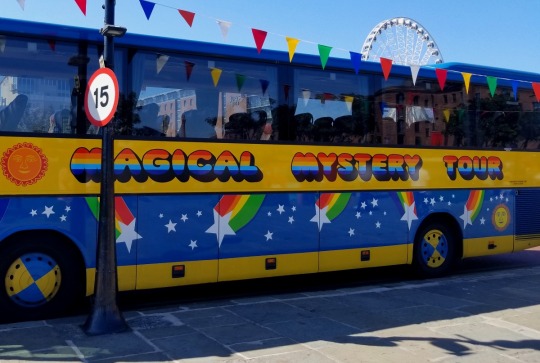
Today we added yet another item to our list of cliche-but-fun tourist activities: the official two-hour Magical Mystery Tour of Beatles holy sites in and around the city of Liverpool.
The tour started outside the Albert Dock. We managed to drag ourselves down to the waterfront with plenty of time to force some food and caffeine into our bodies after another unrestful night.
The tour was led by a man with a tenuous connection to the band but a sincere appreciation for them and what their career has done for the entire city of Liverpool. We saw a lot of interesting places, and I learned a lot of Beatles history. A lot of this is probably elementary-level stuff for most people, but I won’t try to guess which parts--it was pretty much all new to me.
We started in the working-class inner city and made our way out towards the suburbs. Which meant that our first stop was Ringo Land.

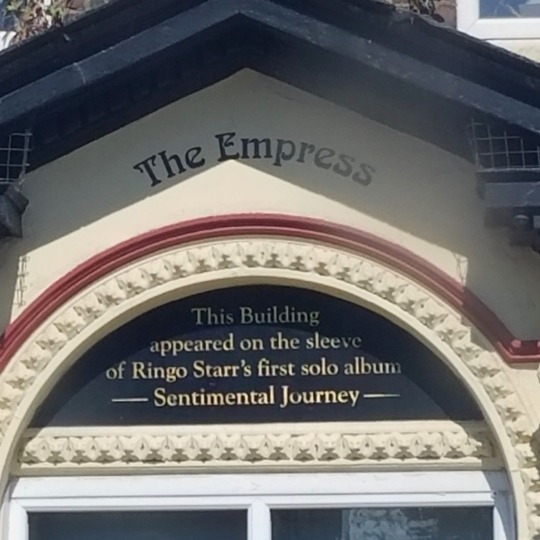
Ringo grew up hard, with an absentee father and chronic illnesses that kept him out of school for years at a time. As a result, he had little traditional education and few friends. He was the oldest and last member to join the Beatles, having already launched his musical career as a member of two other bands.
Even I knew that Ringo wasn’t the original drummer for the Beatles--that was Pete Best. But Best wasn’t good enough, and as the Beatles started to become really popular, the rest of the band and their manager agreed that it was time for him to go.
What I didn’t know was that Ringo was actually one of two candidates to replace Best. The band’s producer George Martin wanted to hire Scottish drummer Andy White to replace Best, but the band preferred Ringo. They got along better with him, and he was a fellow Scouser. In the end, Ringo won over Martin, and after a rocky first few months, he won over the fans as well. (In the meantime, bodyguards had to be hired for protection from vengeful Best fans.)
Our guide pointed out a street where the Quarrymen--the band that would become the Beatles--had their first public performance 1957, during Liverpool’s 750th-anniversary celebrations. Apparently, it went disastrously, but luckily they didn’t give up. Though Lennon was the only future-Beatle in the group at the time.

Our next stop was Penny Lane. While the street signs are famously iconic, I learned that the song wasn’t technically named after the lane itself. There was the Penny Lane bus terminal at one end of the lane, and the whole commercial neighborhood around the terminal became known as Penny Lane.
Today, the terminal has been turned into a restaurant.

This neighborhood was roughly in the middle of the Beatles’ houses, so it made a natural meeting point. Paul’s memories of walking through it formed the basis for the famous song, which he wrote when their manager suggested making more songs about where they grew up.
We also learned about Penny Lane’s darker history. The lane was originally named for James Penny, a wealthy 17th-century merchant who made his fortune in the international slave trade and lobbied openly against its abolition.
Recently, there have been calls by some to rename Penny Lane. But the dominant opinion is to keep the name, in recognition both of the sad fact of slavery and of the brighter cultural significance the name has taken on since.

We saw George Harrison’s first childhood home on Arnold Grove. Harrison also grew up in a poor, working-class family. The house had an outdoor toilet that froze in the winter and single coal furnace for heating.
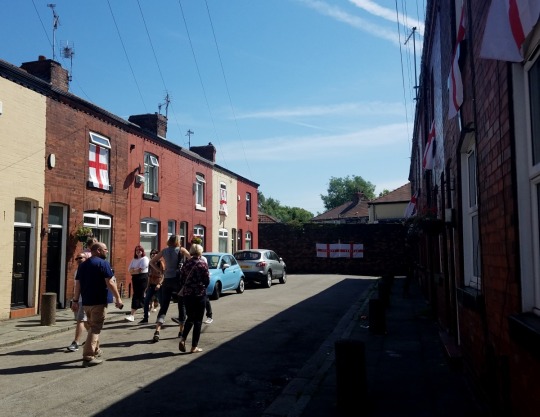
Ironically, the two most politically outspoken Beatles--John and Paul--grew up in relatively cushy middle-class suburban homes.

On the way out to the suburbs, we saw St. Peter’s Church, where “The Most Important Moment In Music” took place. More specifically, it was where John and Paul first met. John didn’t immediately take to Paul, but Paul could tune a guitar better than anyone else in the band, so he was in.
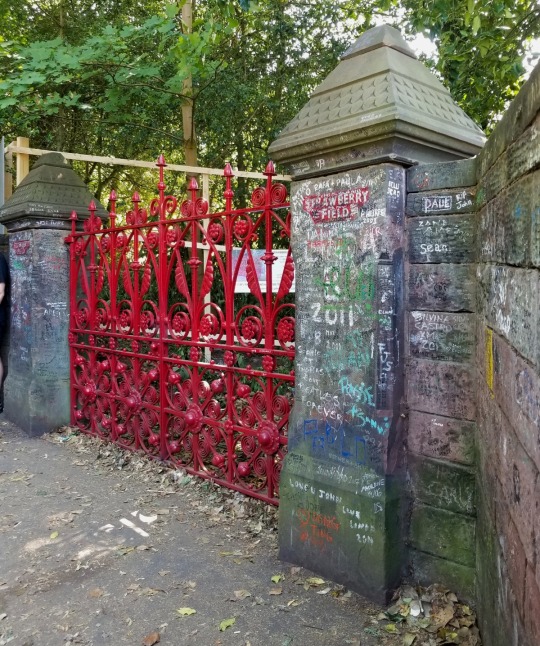
While Penny Lane was Paul’s tribute to Liverpool, Strawberry Fields was John’s. Strawberry Field was actually a girls’ orphanage near the house where John lived with his aunt Mimi, and John would sneak out and peer down into the grounds from a nearby tree. John’s aunt would chastise him, saying that he’d be hanged if the girls ever caught him. But John insisted, as he said in the song, that it was “nothing to get hung about.”
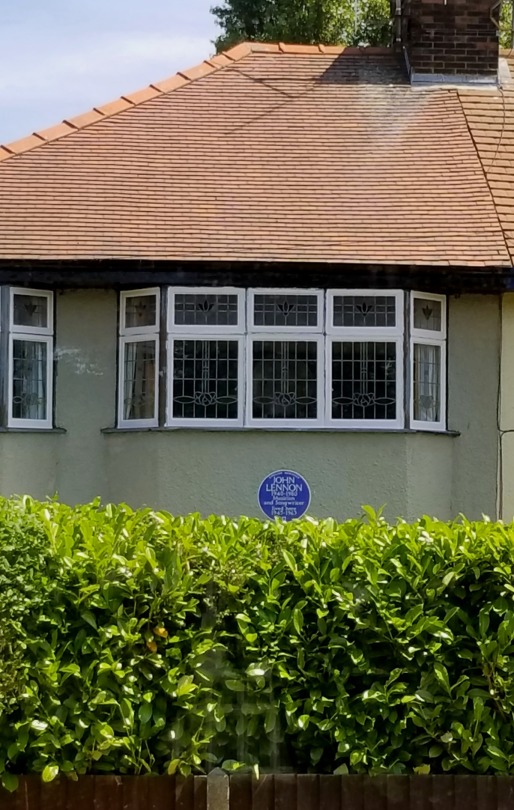
We saw his aunt Mimi’s house, named “Mendips,” where John would creep over to the orphanage from and where he lived for most of his childhood--having been given to his aunt at a young age by his mother Julia. John’s parents had a short and tumultuous relationship, and his father left them when John was a young boy. They never divorced, but Julia went ahead and moved in with another man.
No one knows for sure why Julia gave John to Mimi--it could have been that she didn’t think that she was motherly enough, that her new boyfriend didn’t want John living with them, or that Julia’s family didn’t want John exposed to her arguably adulterous lifestyle. It was probably a combination of all three.
I learned that Julia was killed by a drunk driver when Lennon was a teenager. The driver happened to be an off-duty police officer who didn’t even have a full driver’s license. The officer got off with a slap on the wrist, cementing John’s lifelong distrust of authority figures.
The tragedy also became a point of bonding between John and Paul, who had also lost his mother Mary at a young age.

The last house we saw was Paul’s teenage home on Forthlin Road. It’s where many of the Beatle’s earliest songs were written, and the National Trust bills it as the “Birthplace of the Beatles.”
We learned that the National Trust has gone through great effort to restore and maintain the house in its original condition. When the Trust acquired the house in 1995, virtually all of the houses on the street had undergone renovations over the years as windows, roofs, and fixtures needed replacing. By going through all the houses on the street and making their owners generous offers, the National Trust was able to piece 20 Forthlin Road back into perfectly original condition.
Because there is almost no chance of replacing anything again if it breaks or wears out, the National Trust is very controlling in how many people it lets in. Only a few small groups are admitted on any given week, and spots need to be reserved far in advance.
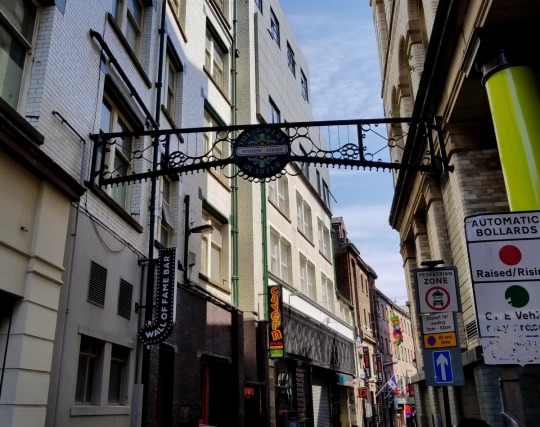
The tour ended back at the Cavern Club on Matthew Street. Our ticket included admission to the club and a free gift, which turned out to be a postcard.
We stopped for lunch at a nearby Pret-a-Manger, then walked over to another, arguably holier site: Liverpool Cathedral.


Put simply, Liverpool Cathedral is huge! It is the fifth-largest cathedral in the world and one of the tallest non-spired religious buildings in the world. Despite its gothic appearance, it’s actually a relative baby. It was started in 1904 and finished in 1978.
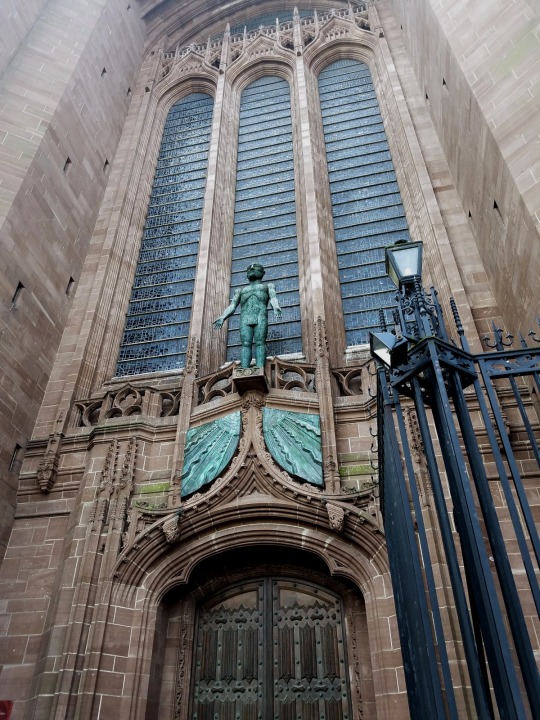
As we entered underneath the massive north windows, we saw one indicator of the cathedral’s modern origin--a decidedly (and controversially) Art-Nouveau interpretation of the Risen Christ.
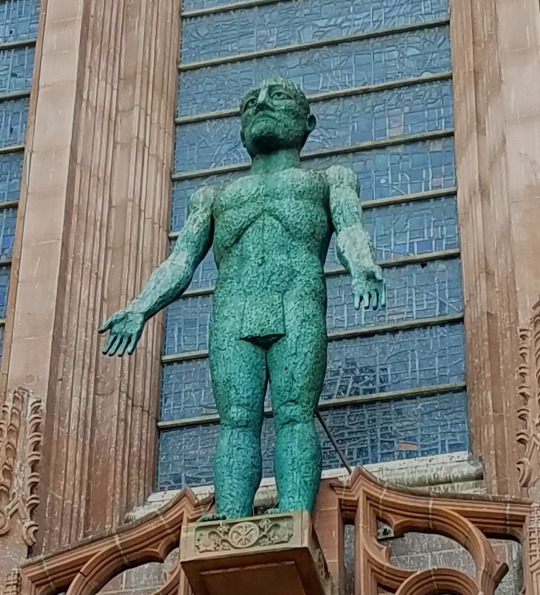
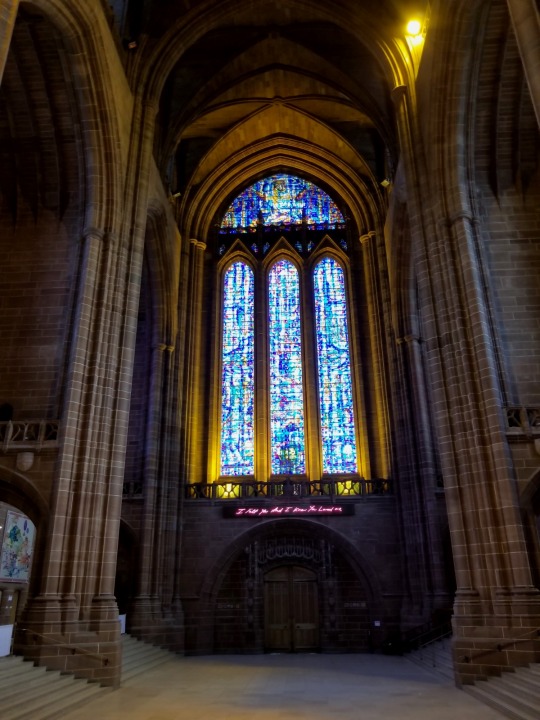
Inside, the cathedral is just as beautiful and huge, with vibrant stained-glass windows towering overhead.
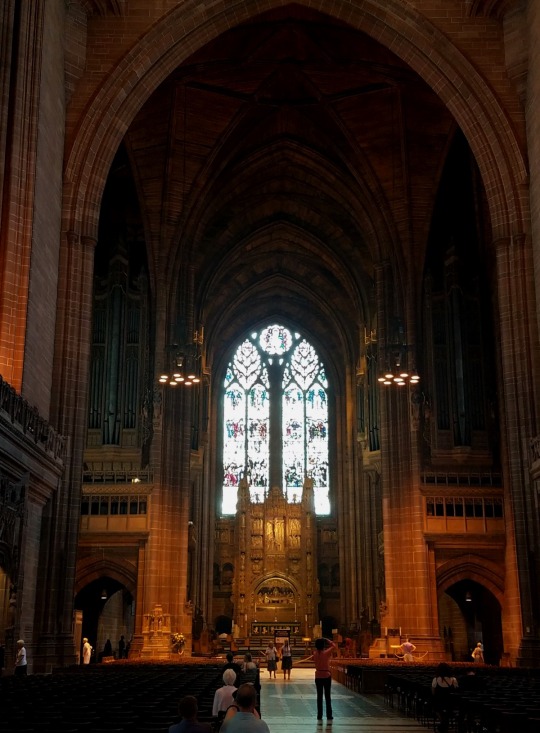

One of the things we absolutely wanted to do here was to go up to the top of the belltower. Jessica and her family had made the ascent a year and a half earlier, suffering from the piercing January winds. We would have to wait, however, because the tower was closed for the next hour because the bells were playing. Part of the climb goes through the bell chamber, and apparently they’re so loud that it’s unsafe for people to go in while they’re playing.
We didn’t mind. It was still brutally hot in Liverpool, and I was happy for all the time I could get to sit in cool darkness and drink from a shared water bottle that we kept refilling from the bathroom sinks.

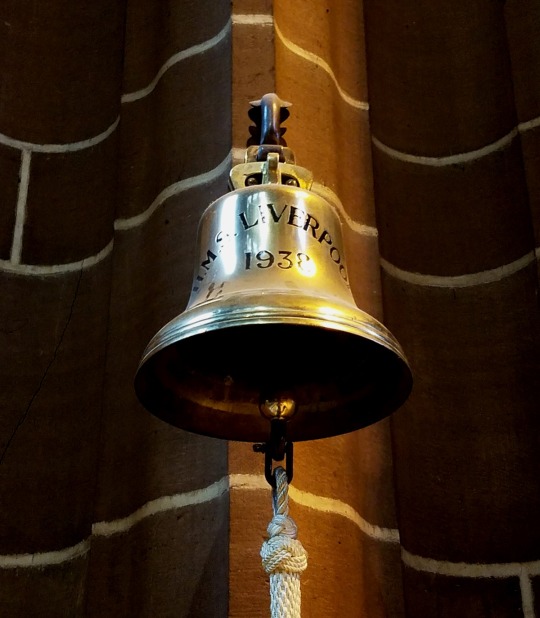

Finally, it was time for us to make the ascent. As we waited in line for the tower to reopen, we got to see an interesting display on the unlikely connection between this massive cathedral and the iconic red telephone box. (Of course, Jessica had already told me all about it.)

Long story short: the guy who designed the cathedral, Giles Gilbert Scott, was the same person who designed the red telephone box, officially designated the K2 cast-iron telephone kiosk.

The bell tower ascent involves two elevator rides. Along the way, you can see the top of the cathedral’s rounded ceiling and the space between the ceiling and the roof.
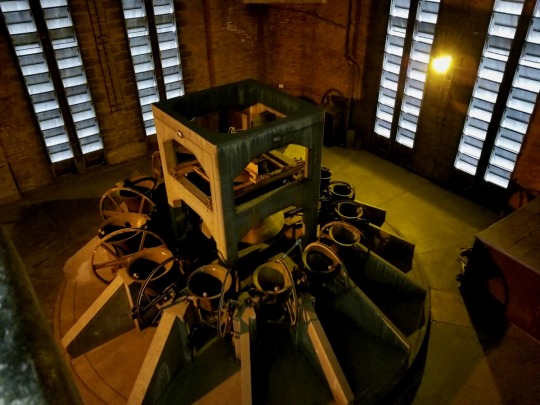
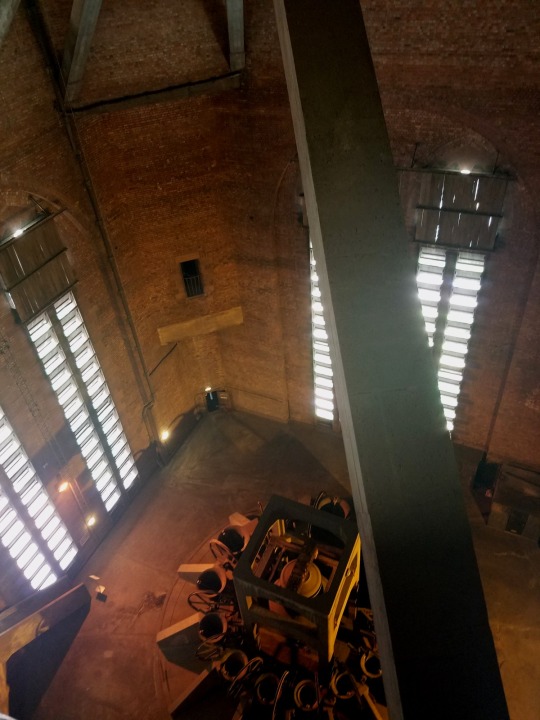
The elevators only take you up as far as the bell chamber. The rest of the climb is made up an unnervingly narrow stairway that spirals along the massive chamber’s walls.

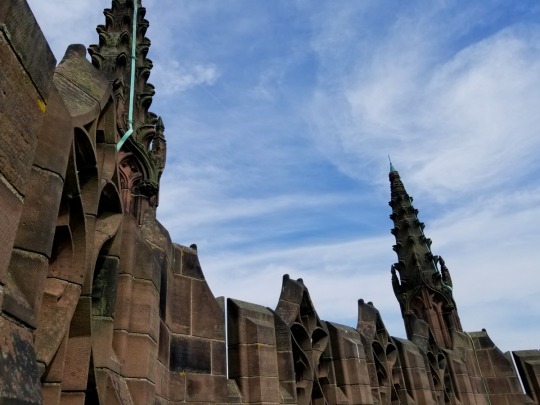
Having made it to the roof, however, the ordeal was well worth it. As we walked around, we got fantastic views of the entire city, including the Catholic Cathedral just down the street.


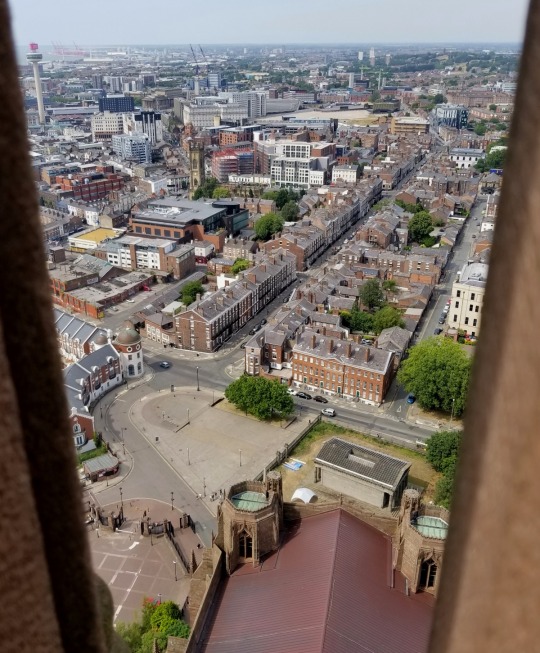
I’m not the best with heights, but the gaps in the wall were narrow enough that the only safety I feared for was that of our phones.

After making our way back down the streets, we headed a couple blocks over for some dinner in Chinatown. Dating back to the 1830s, it is the oldest Chinatown in all of Europe.

We went to a charmingly austere hole in the wall that had good reviews on Google. Jessica got chow mein, and I got fried rice. It was simple but delicious.
As we ate, a local man and his son came in and ordered a feast of a dinner. They were clearly regulars, and the man chatted with the Chinese owners with the familiarity of old friends. Midway through their meal, another man sat down at a nearby table and jumped seamlessly into the banter. Jessica and I just sat quietly and enjoyed the colorful ambiance that transcended anything that any number of fancy carpets or wall hangings could have provided.
Next Post: The Many Museums of Liverpool
Last Post: Anfield
#180abroad#liverpool#england#britain#travel#beatles#magical mystery tour#cathedral#chinatown#noodles
0 notes